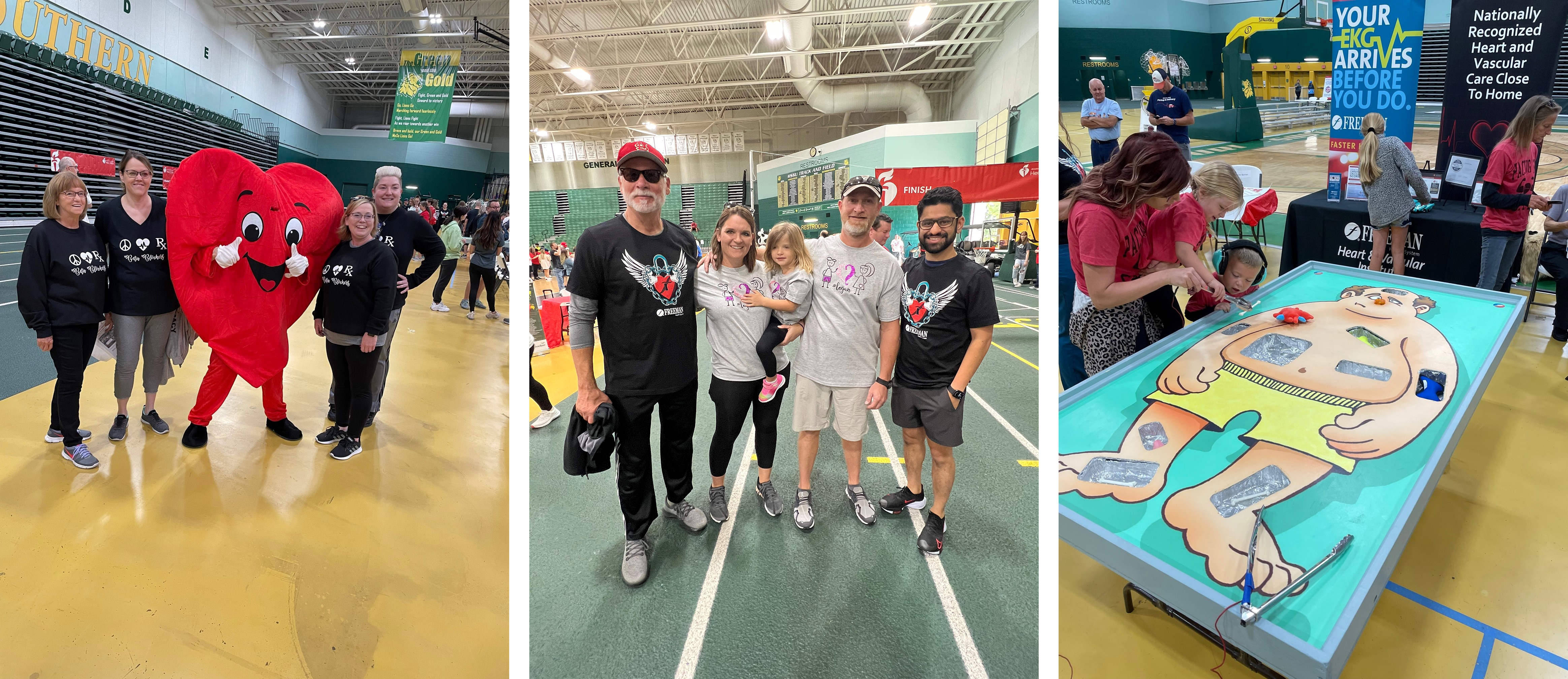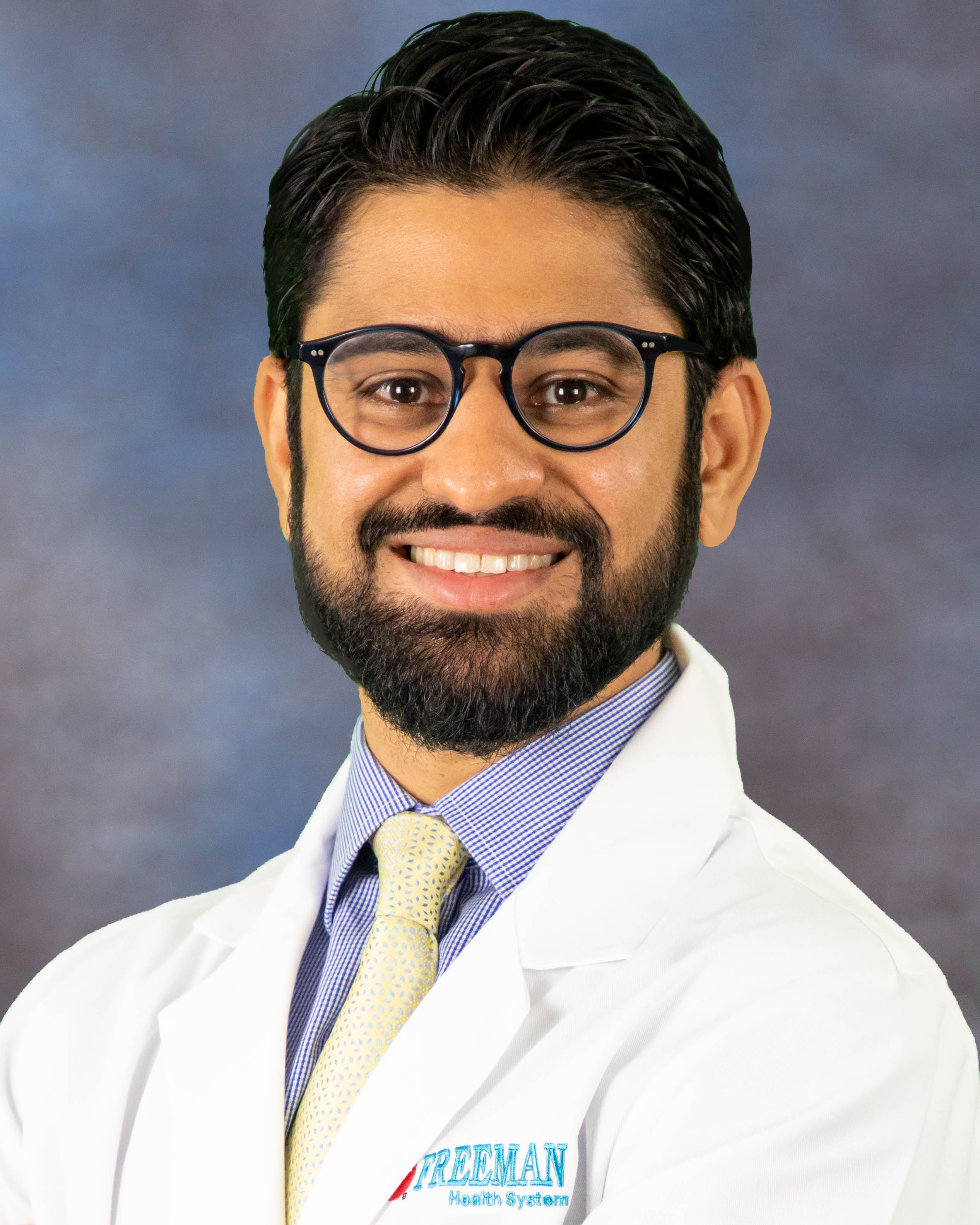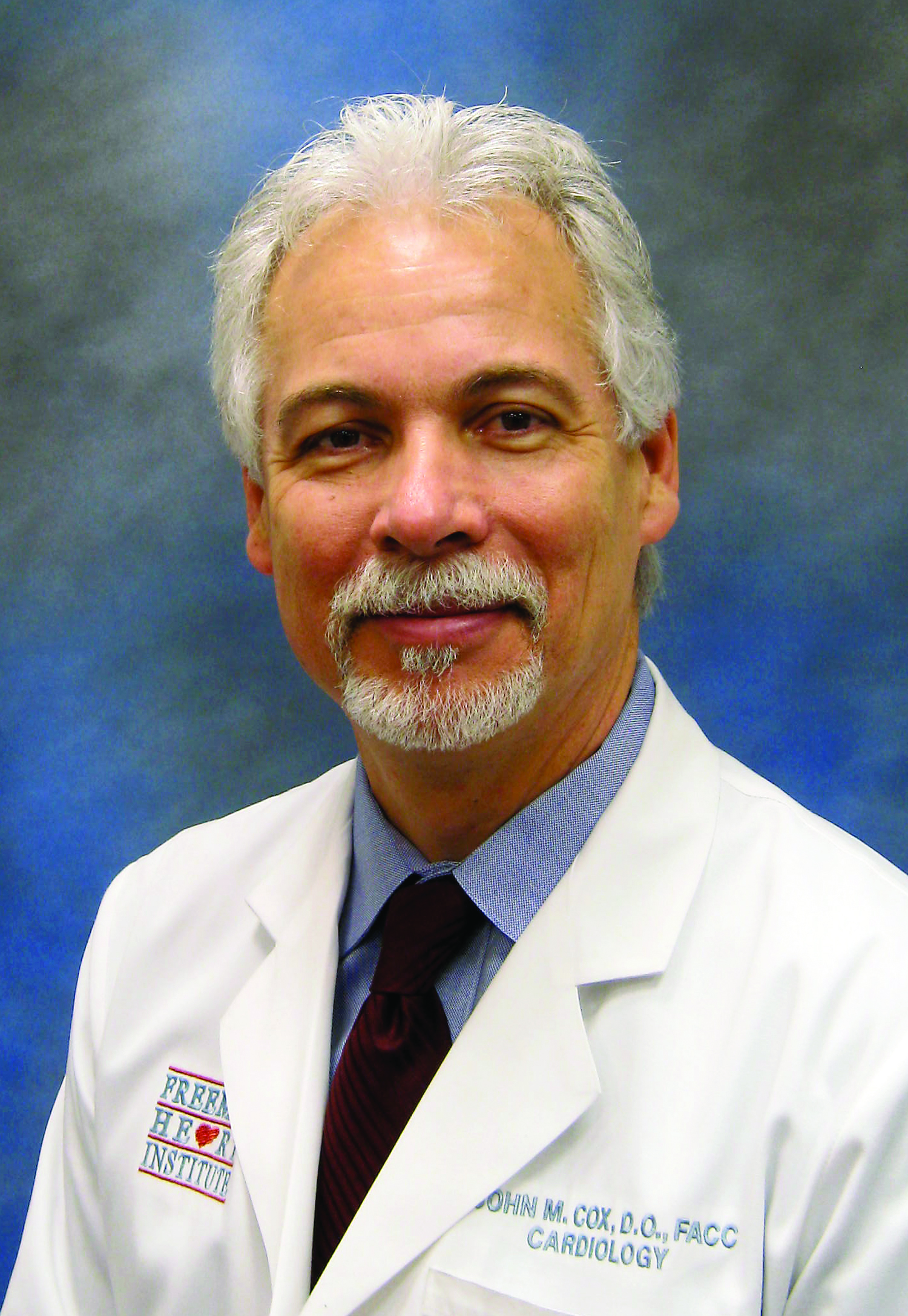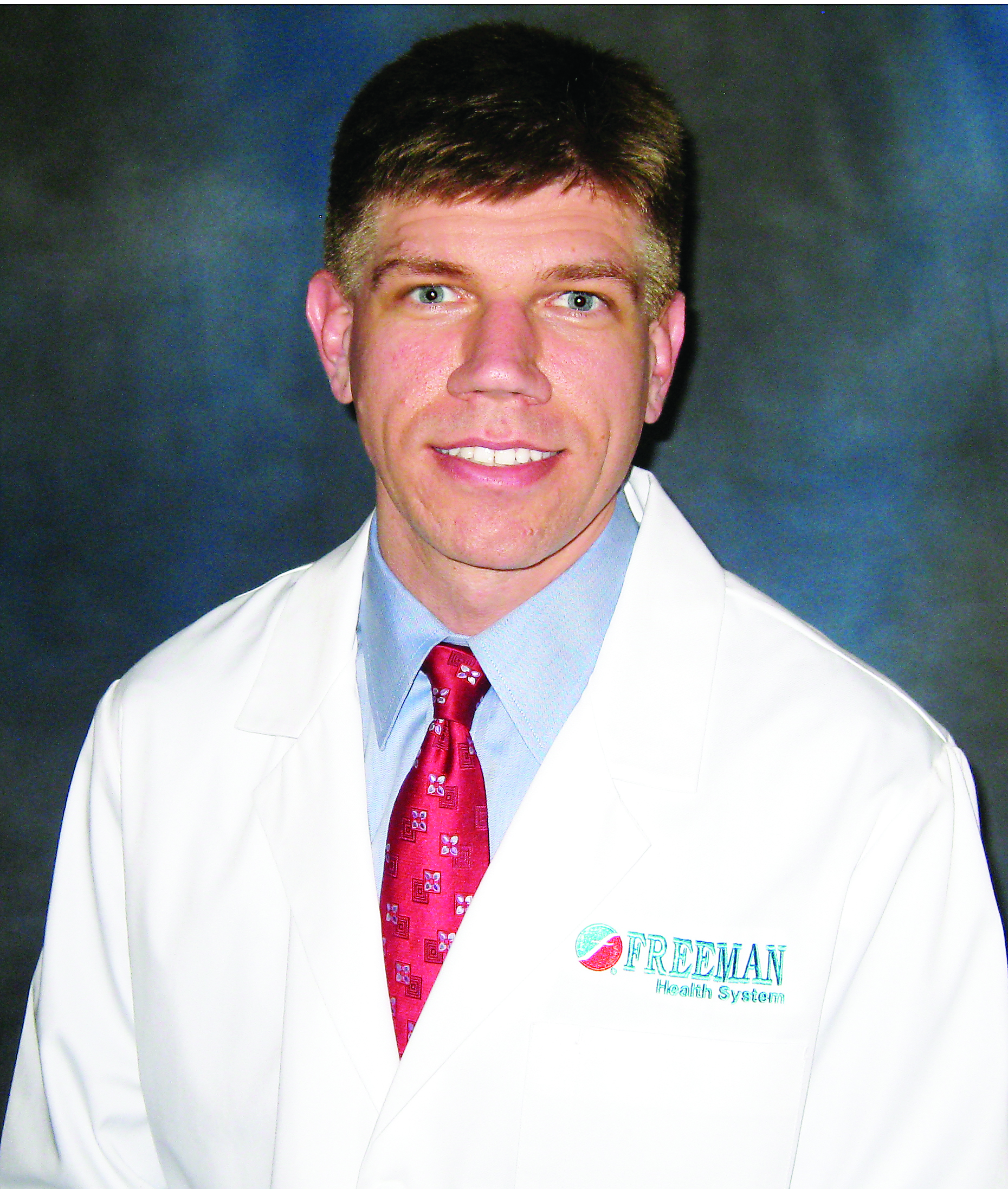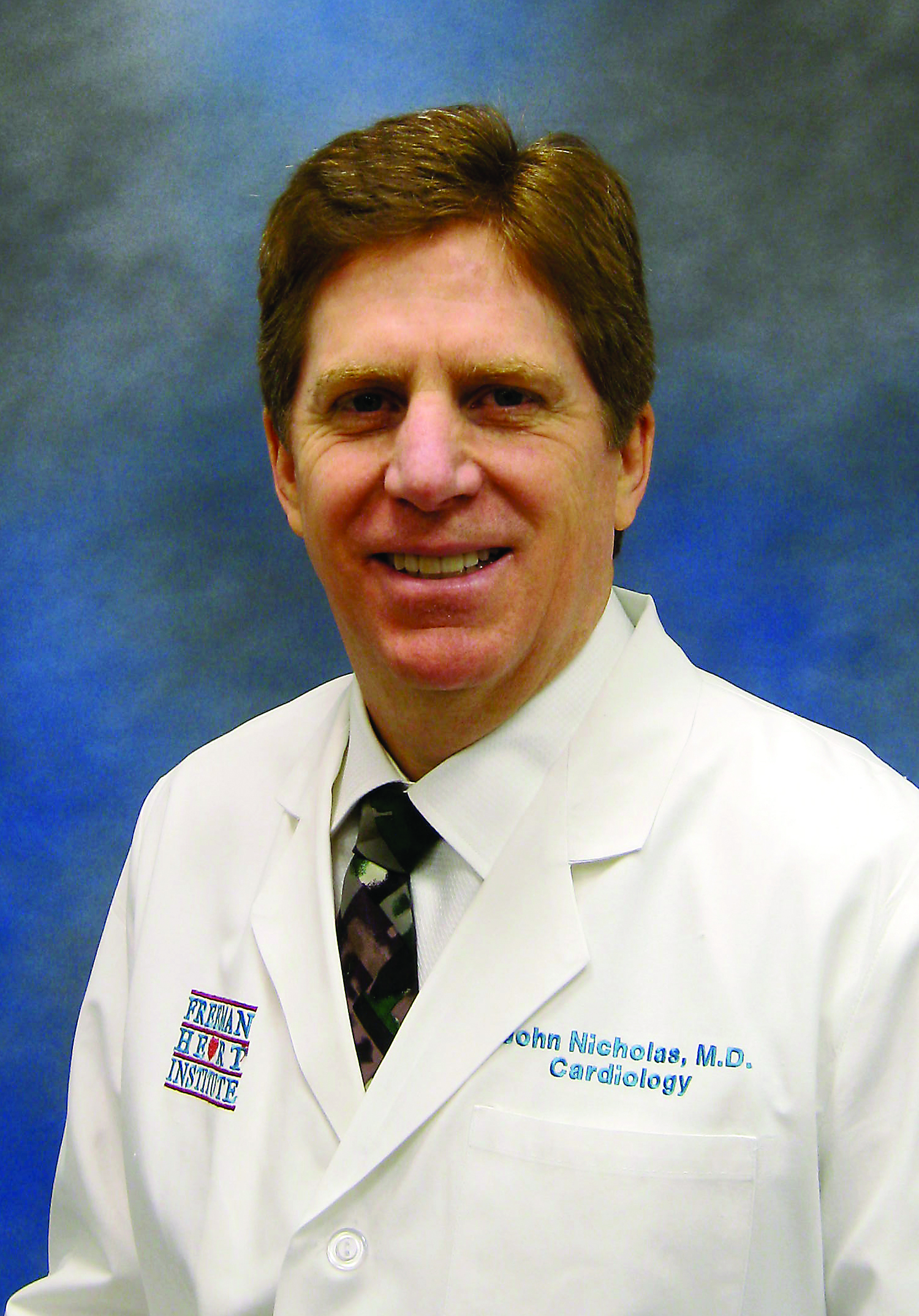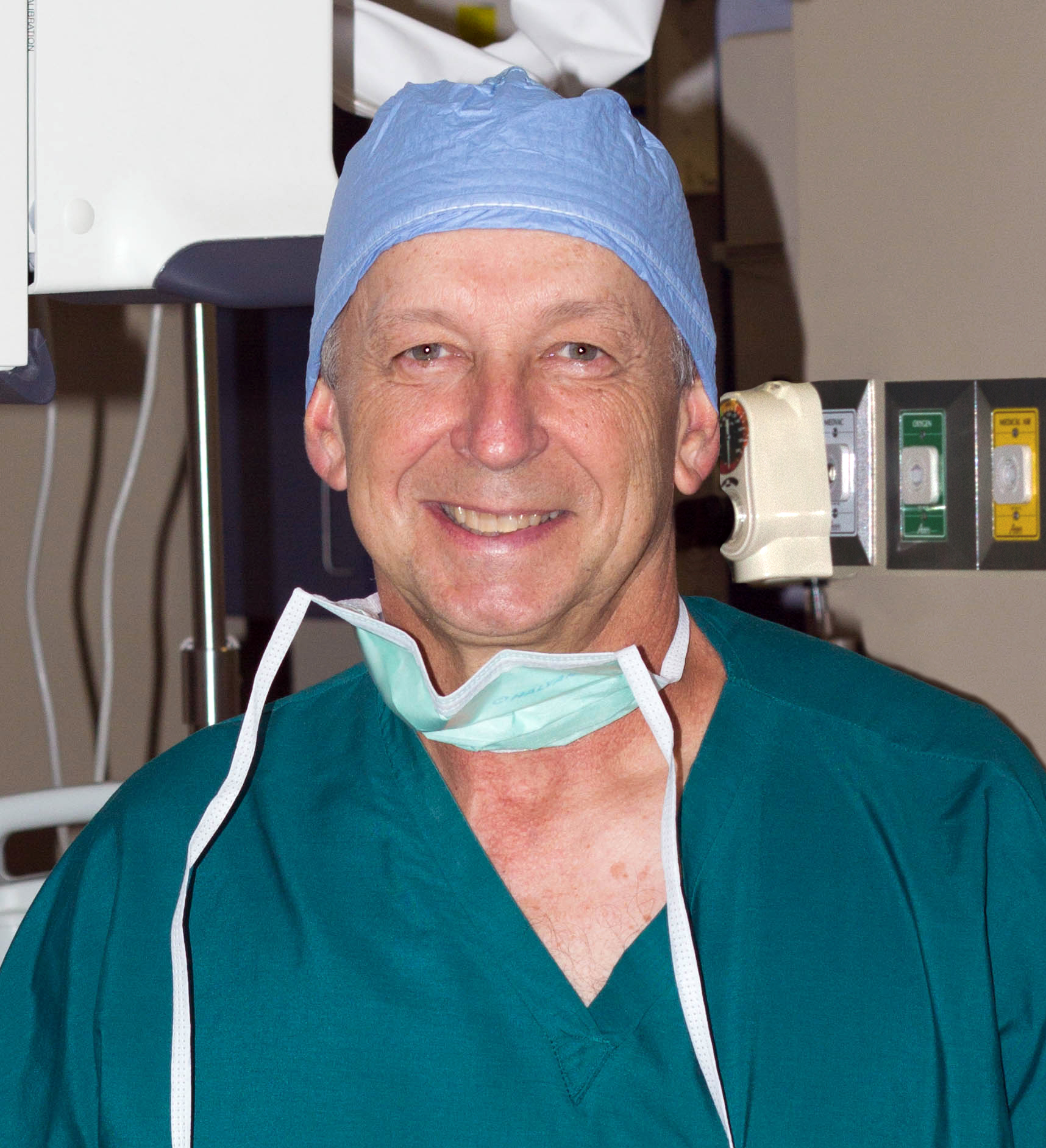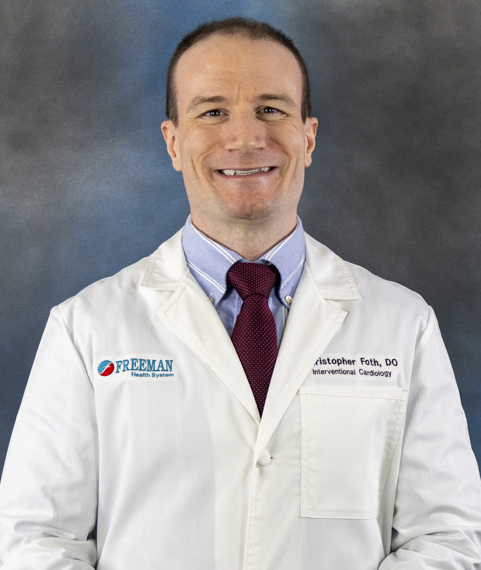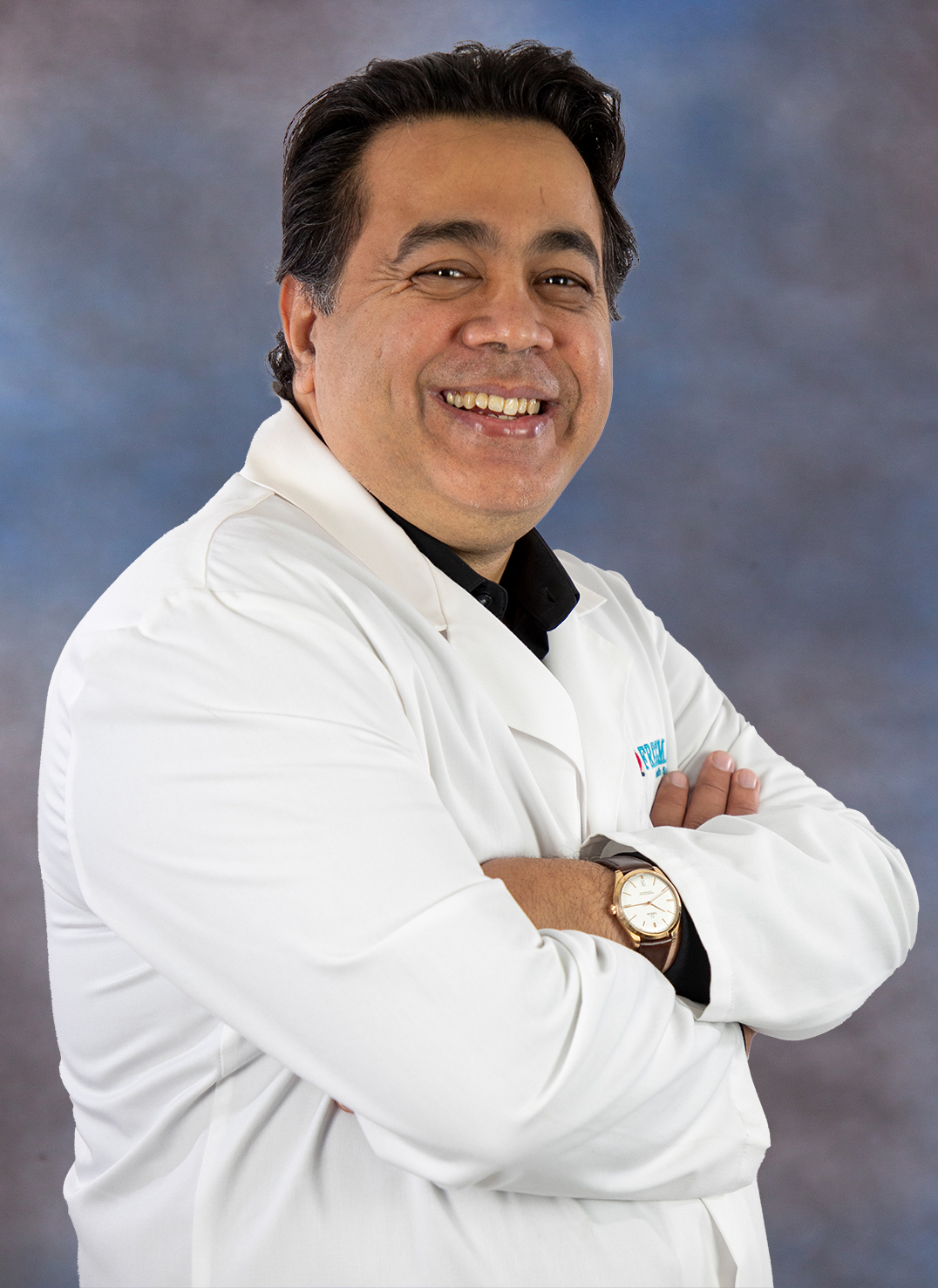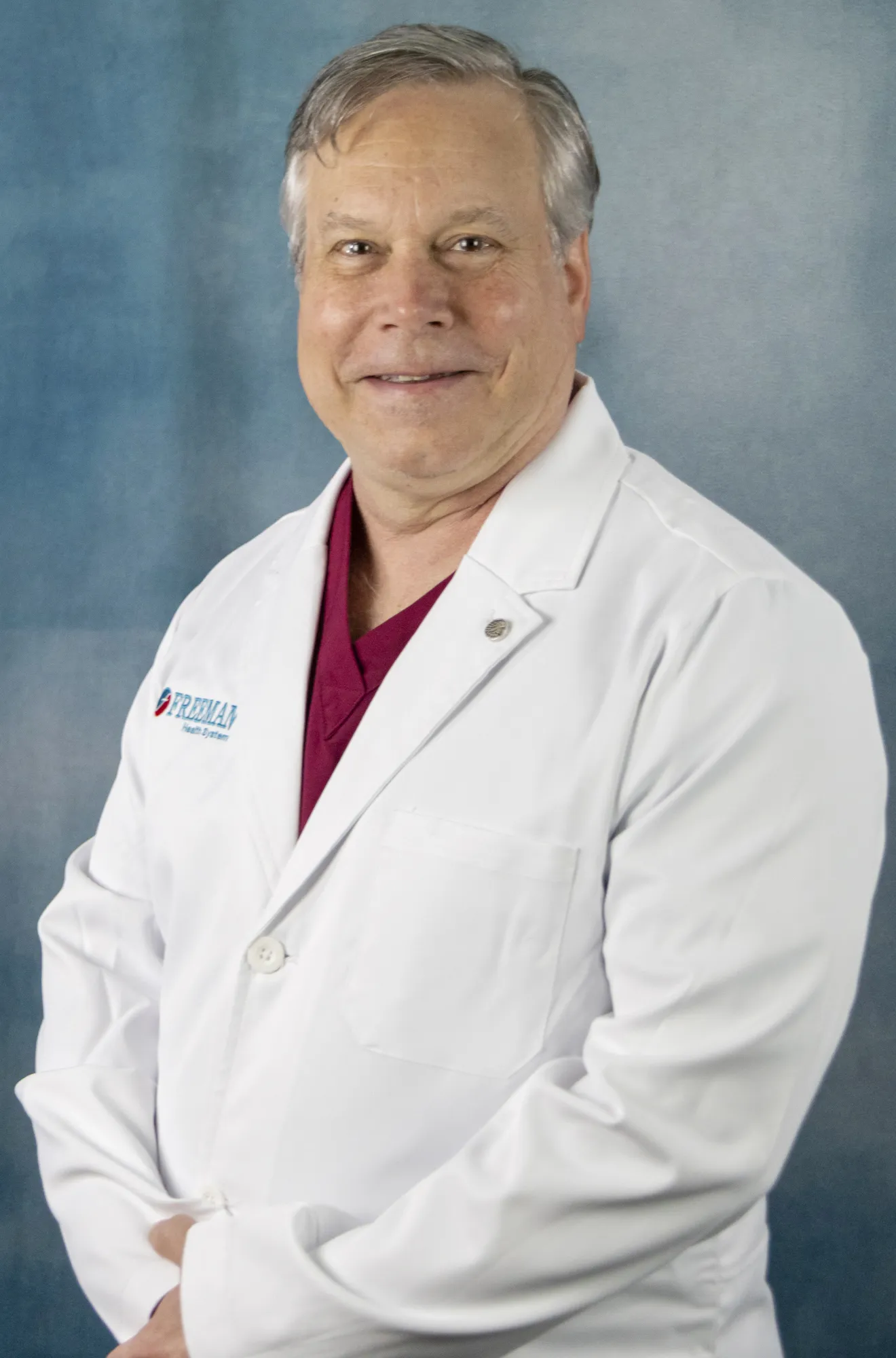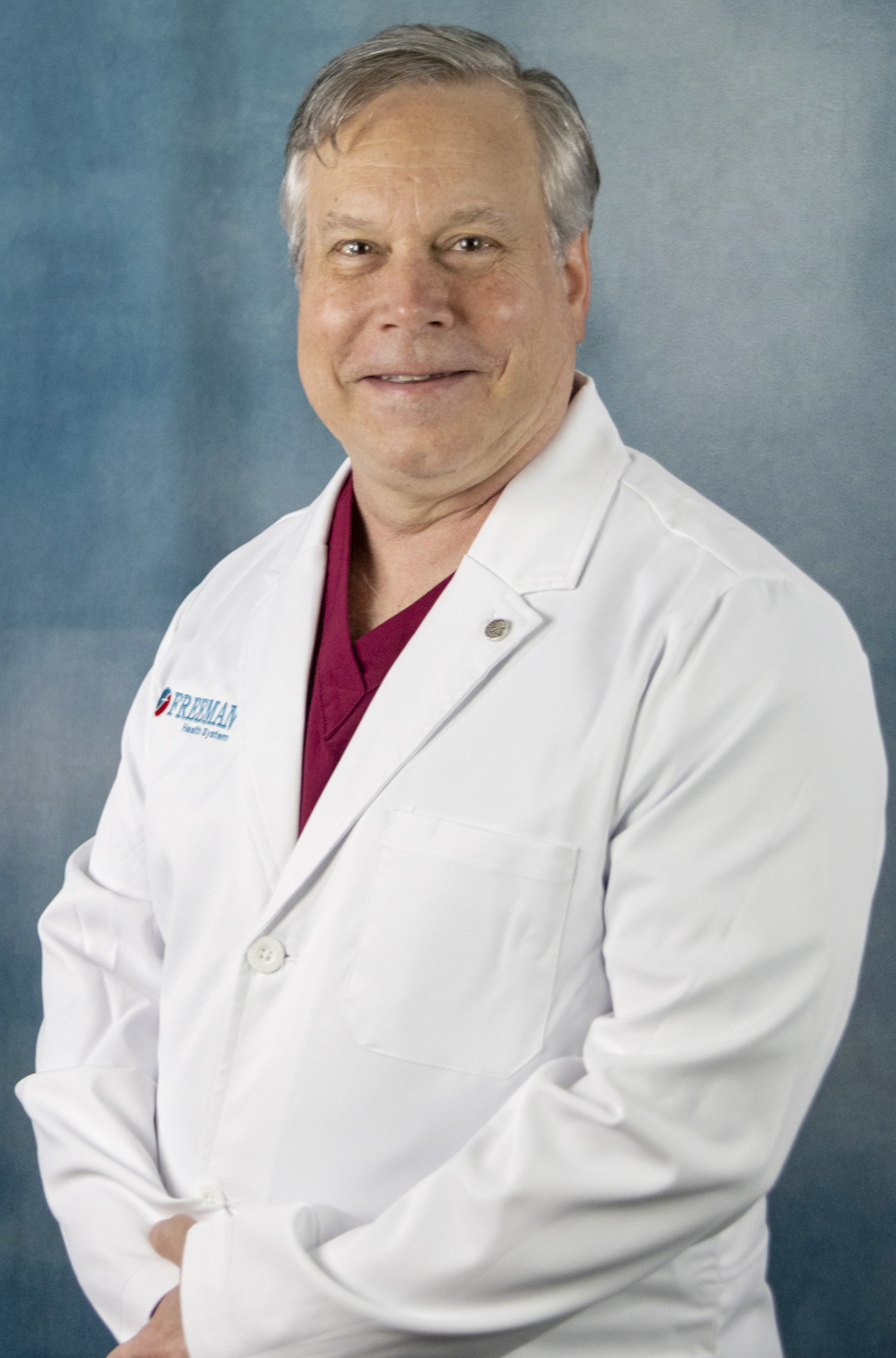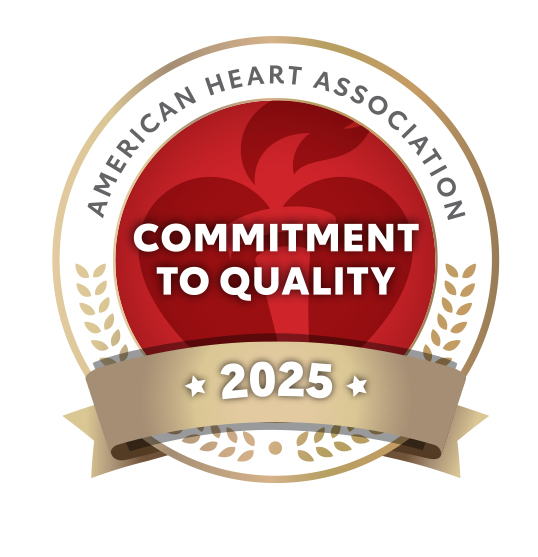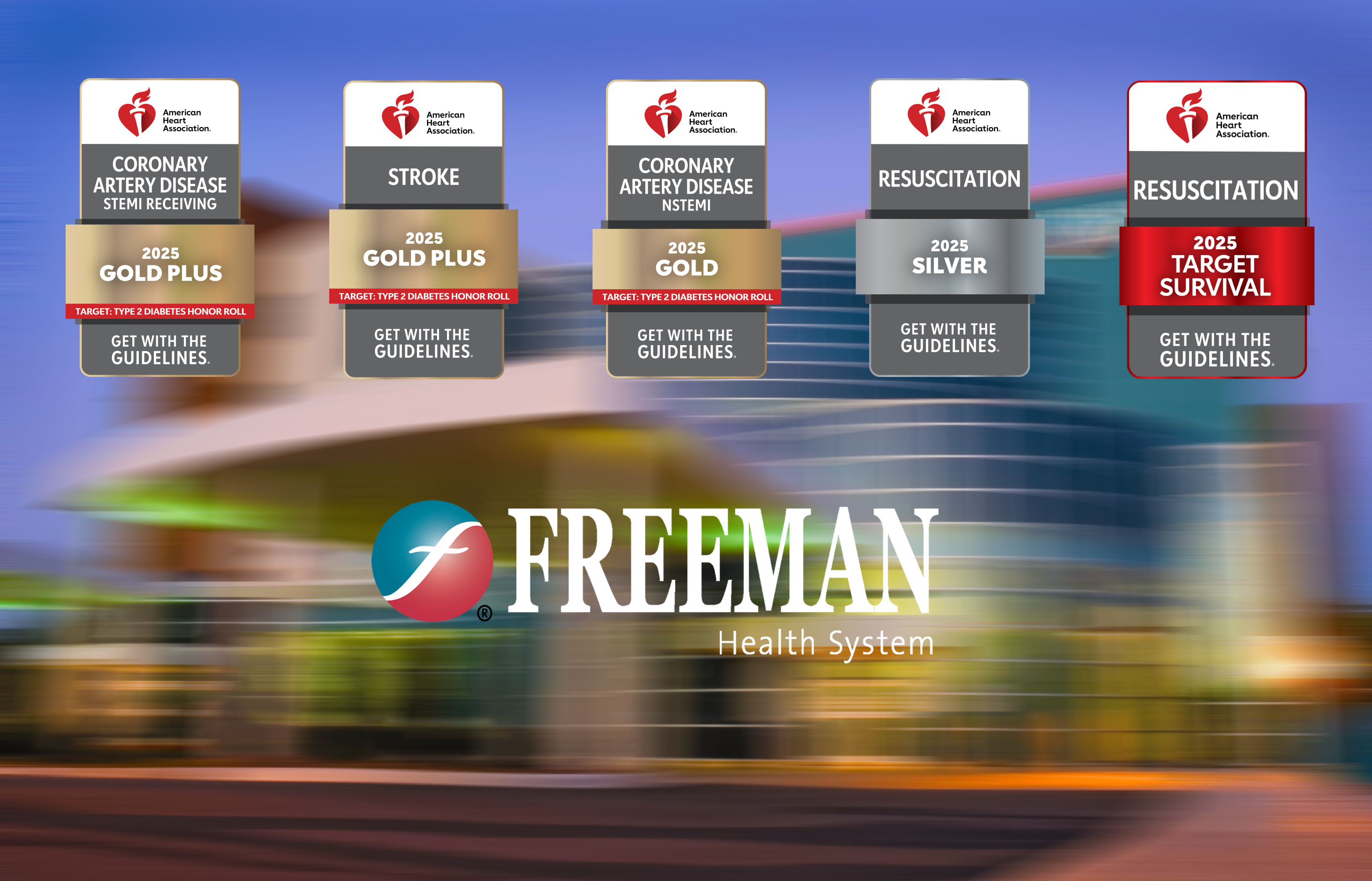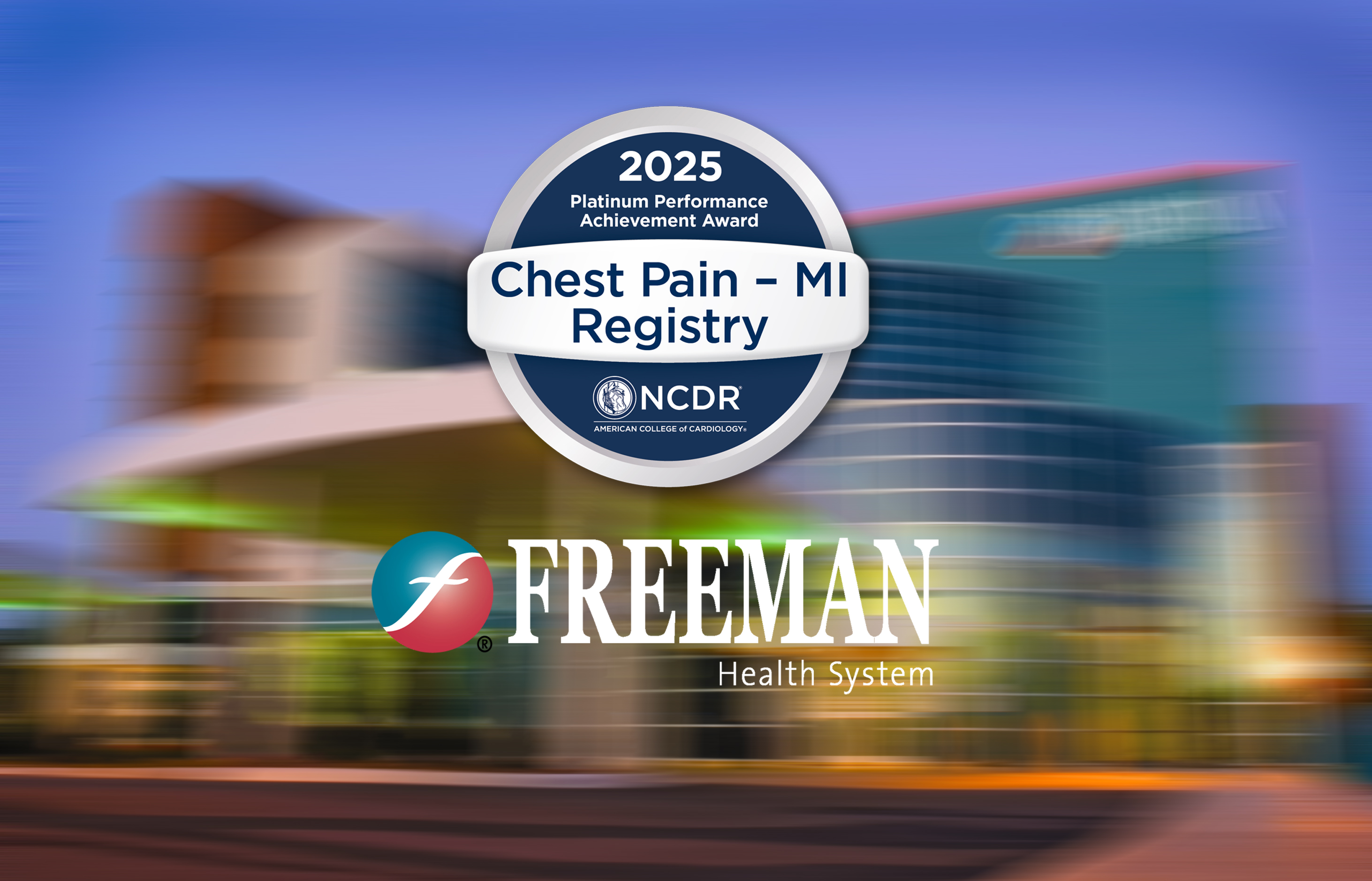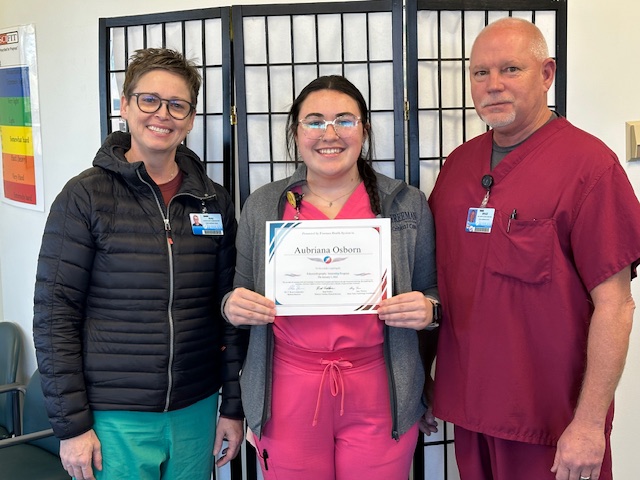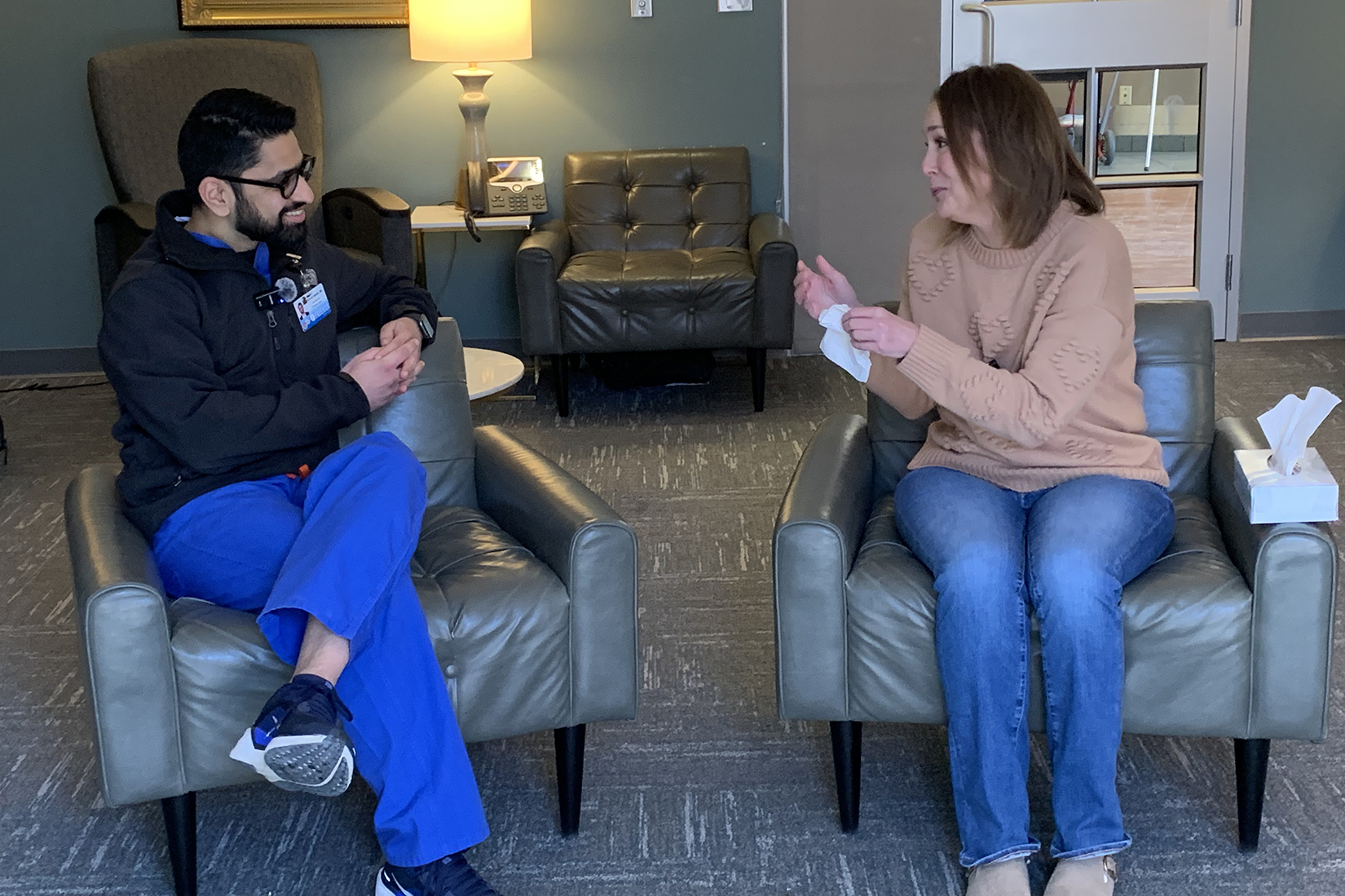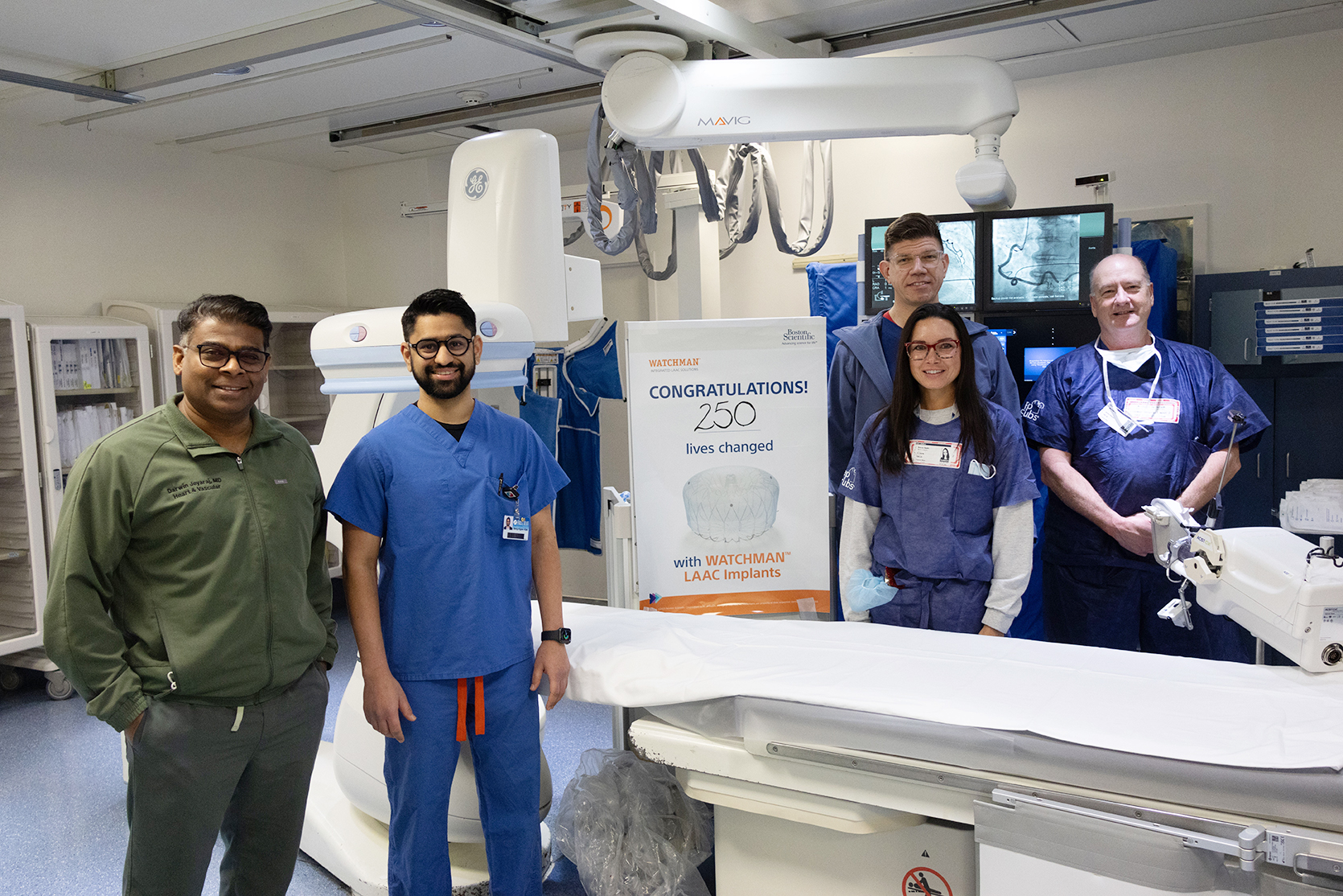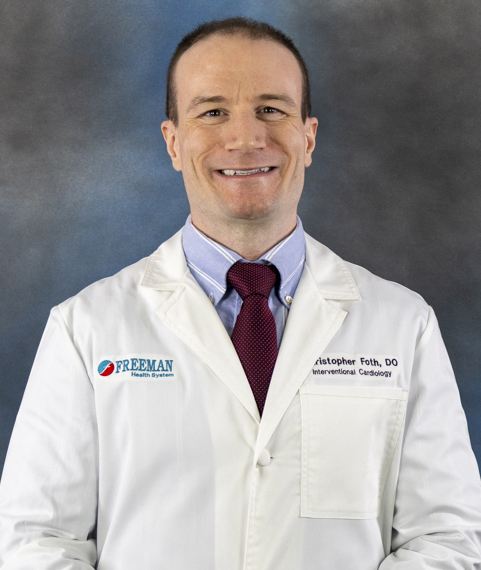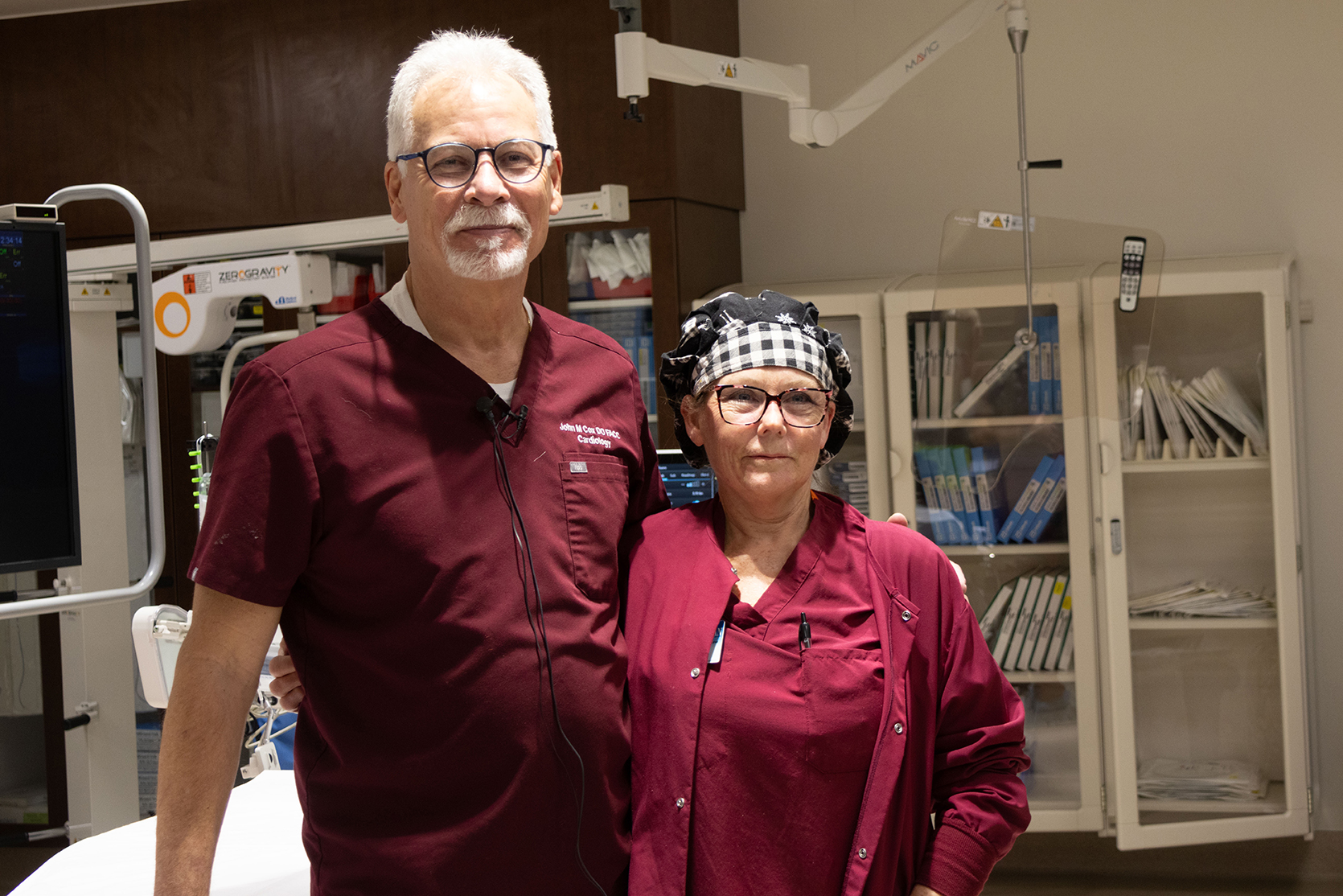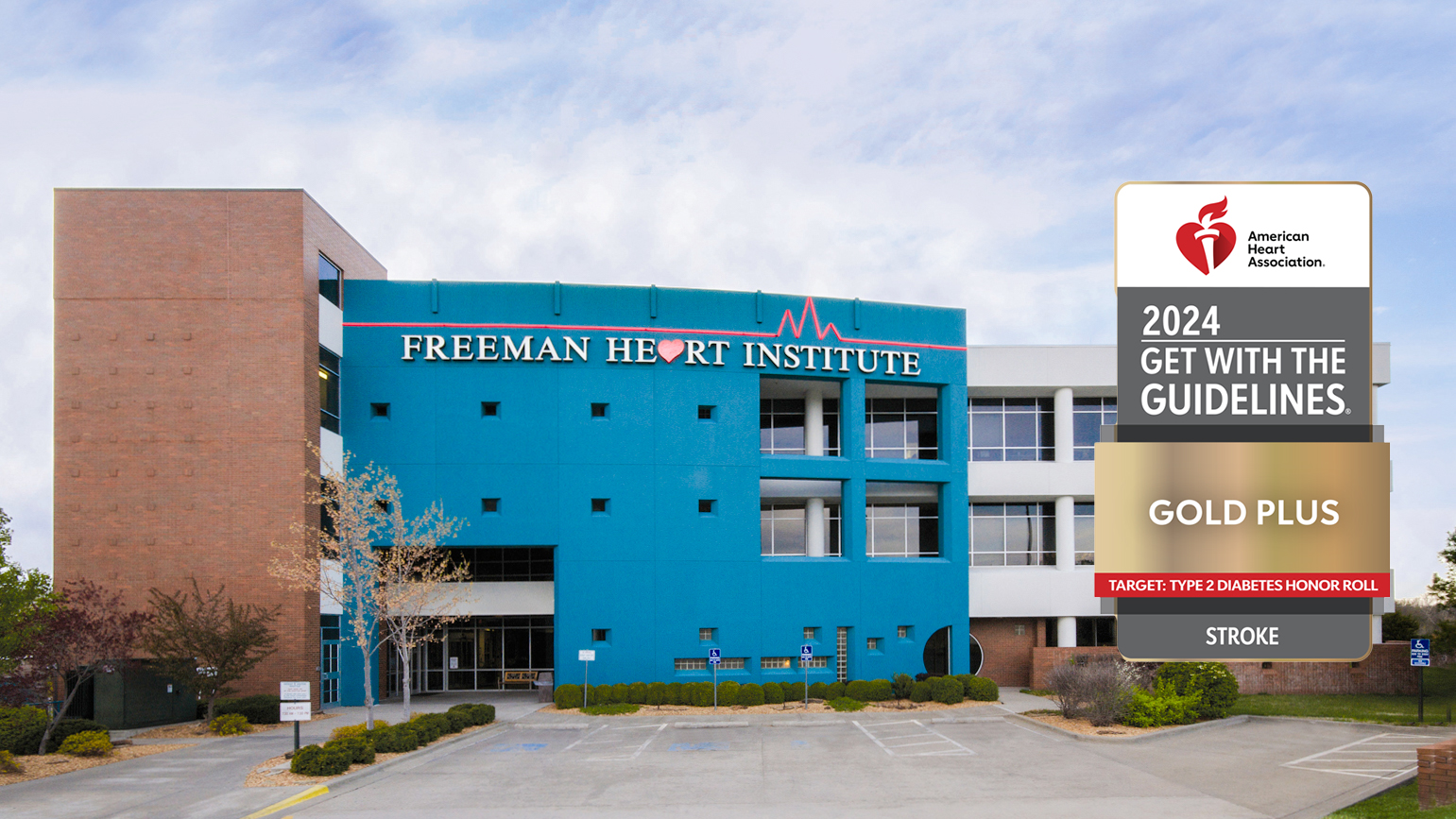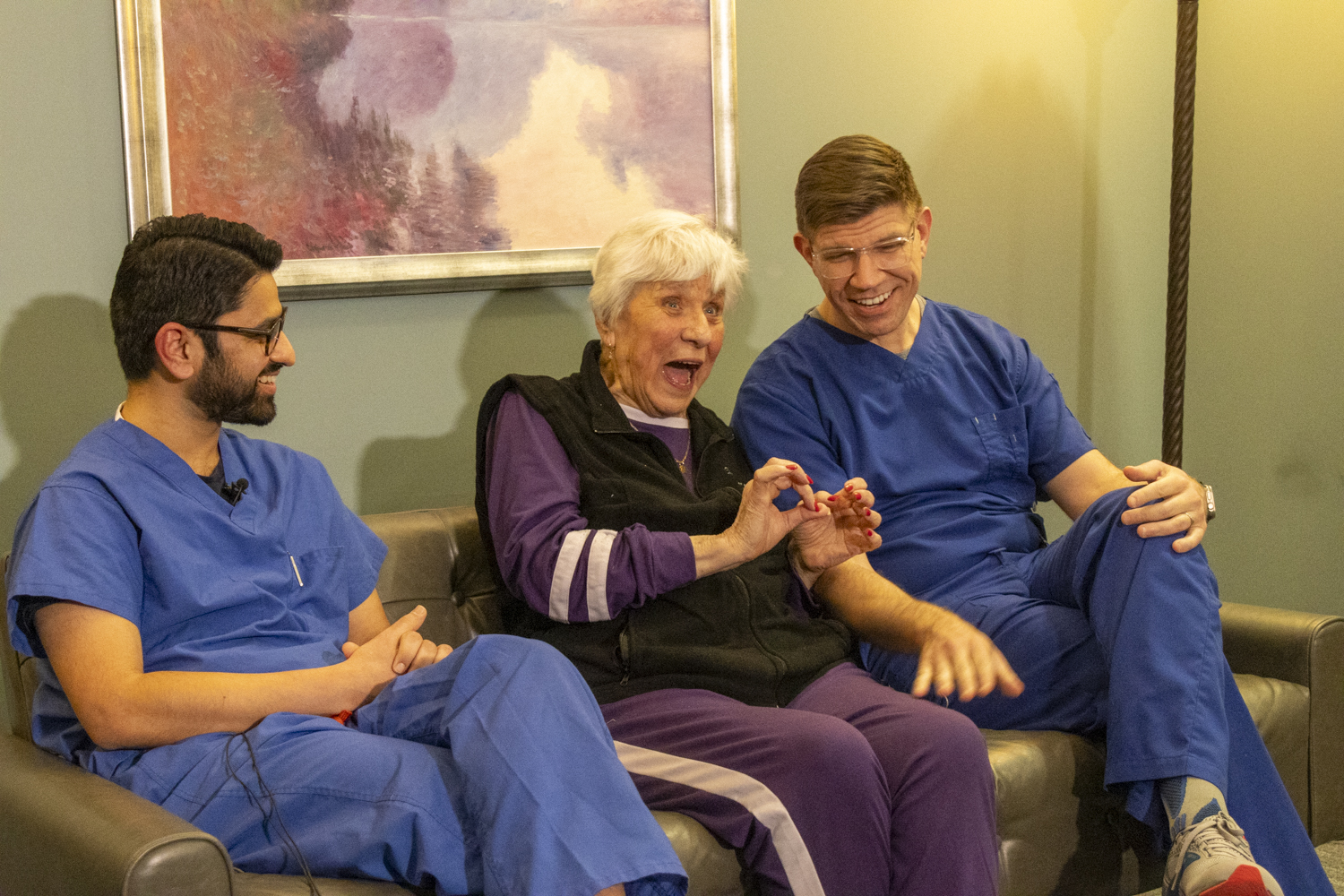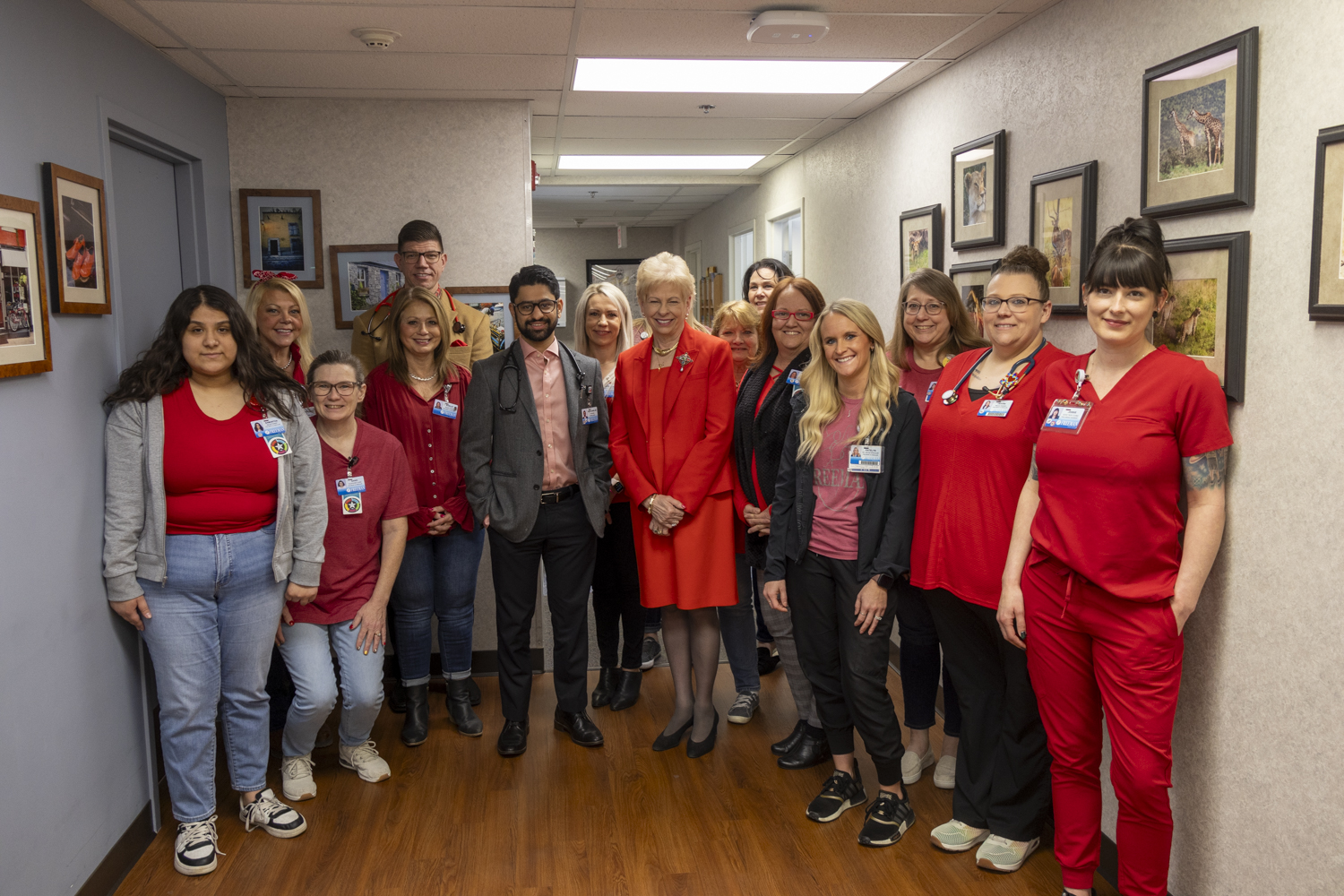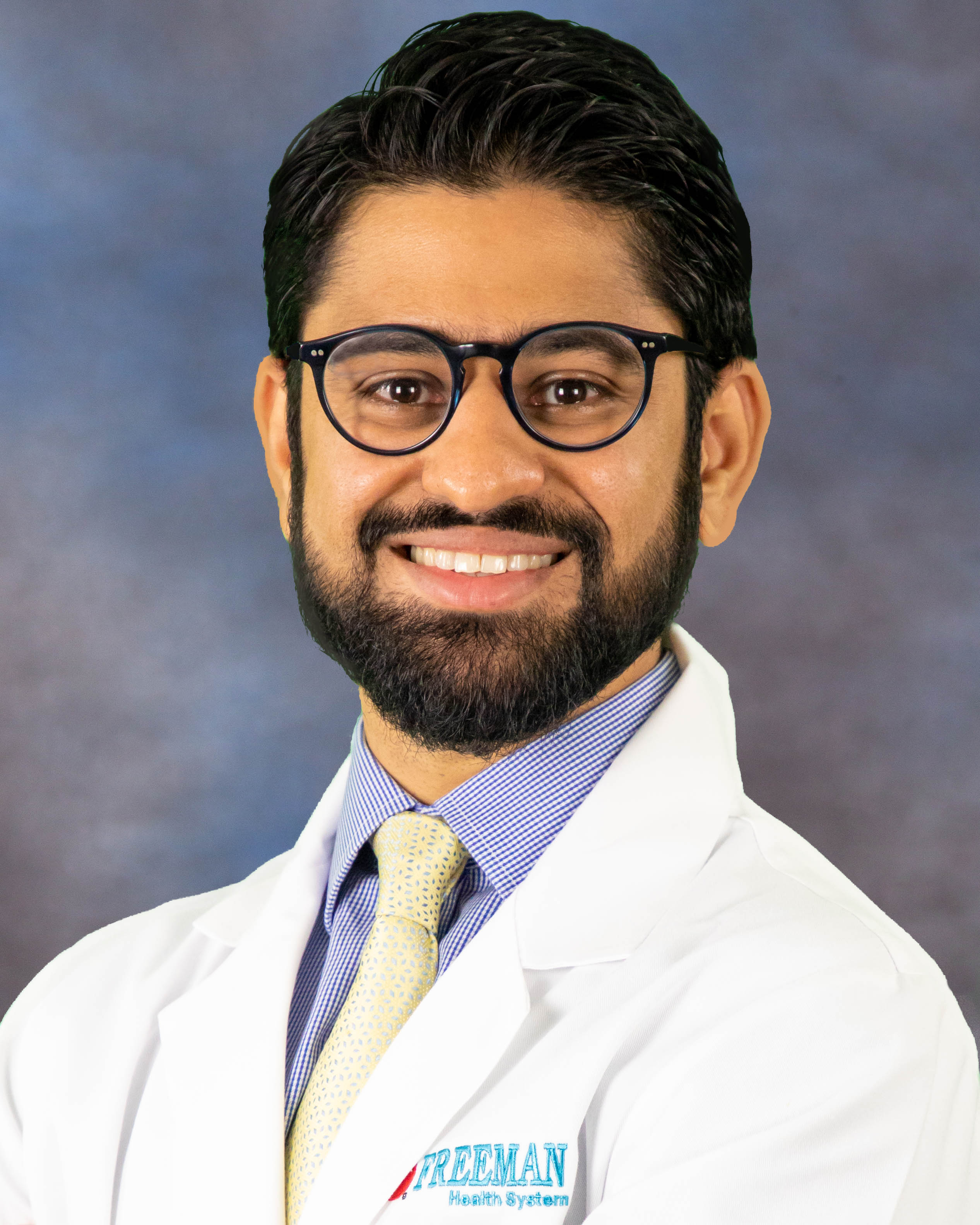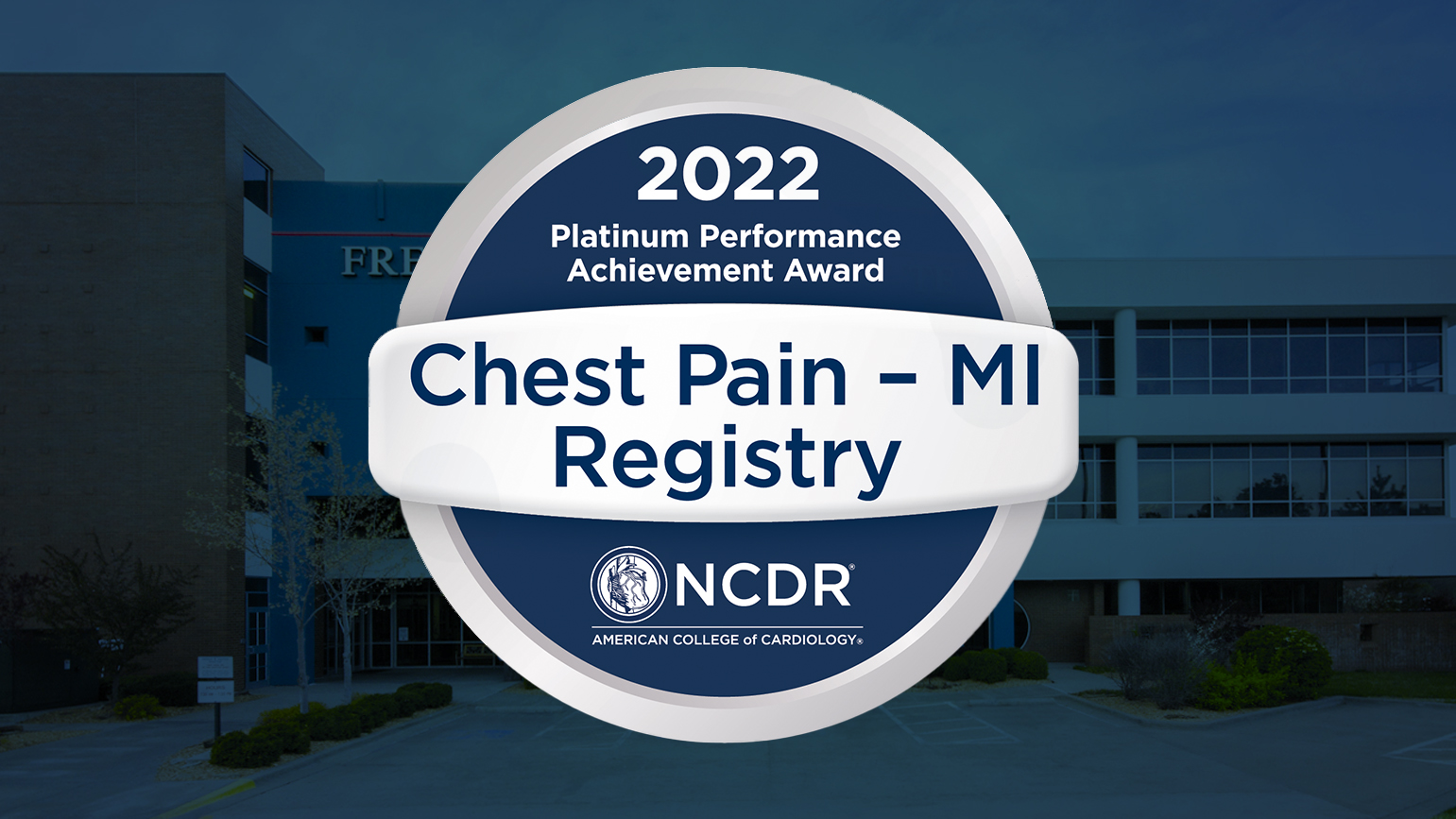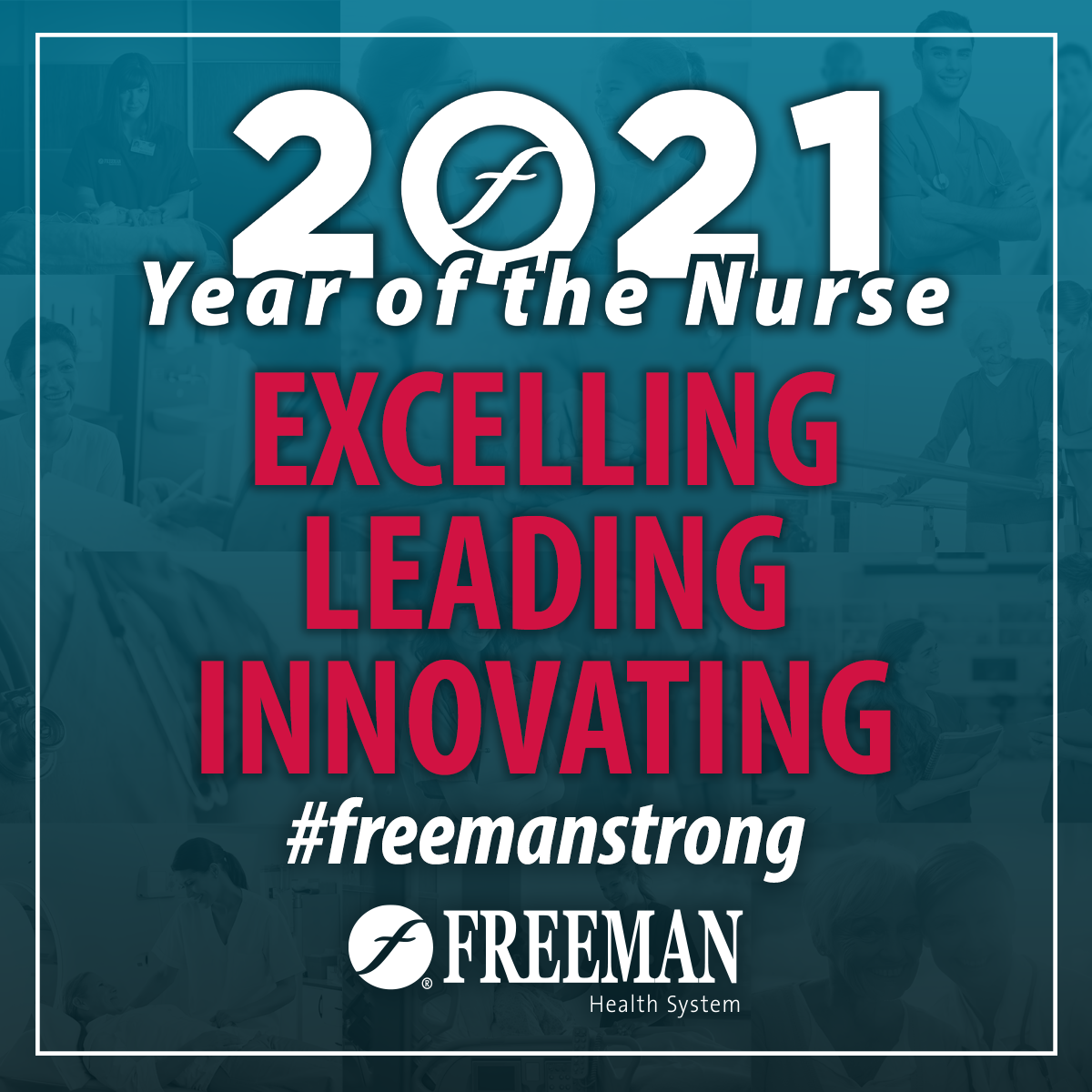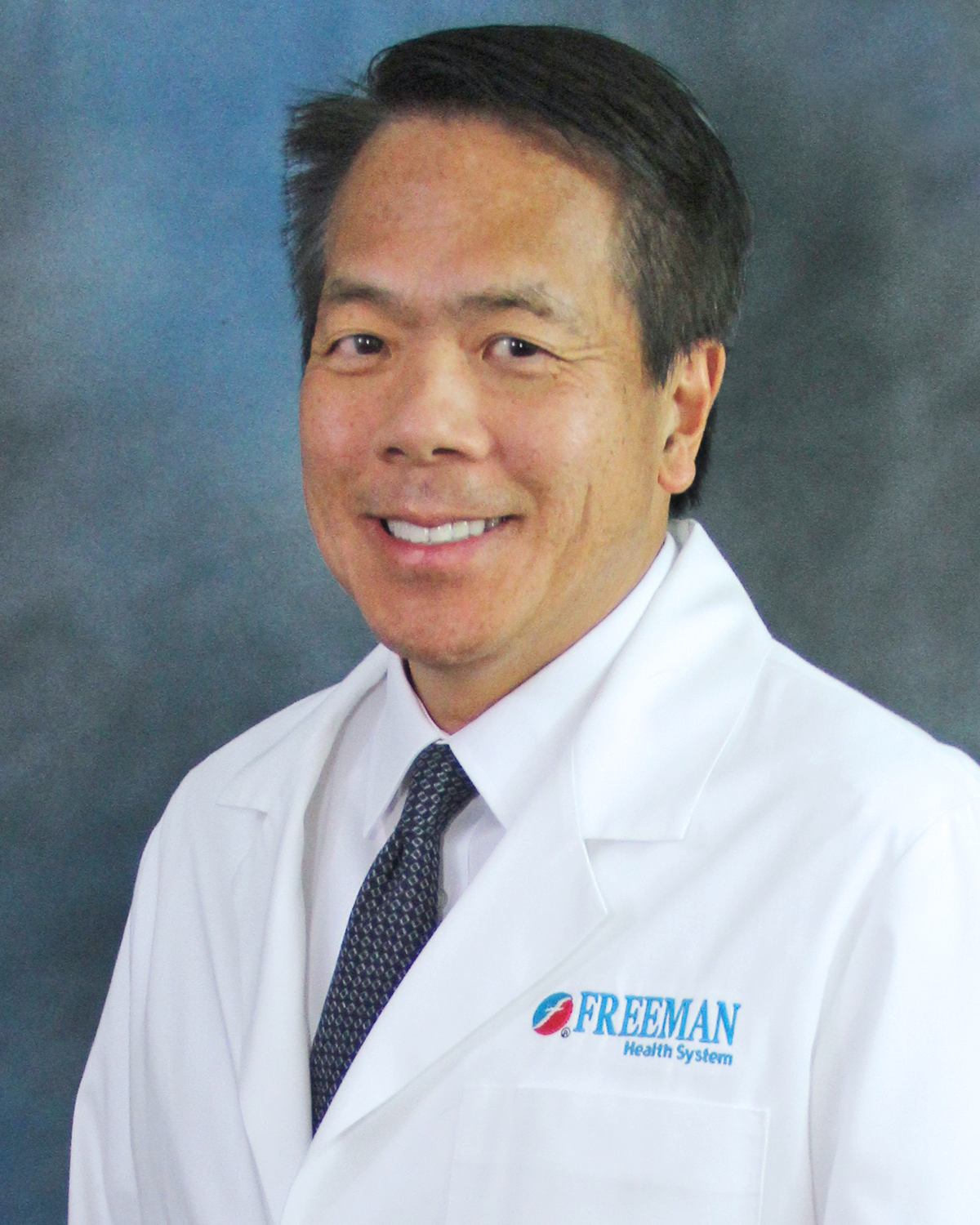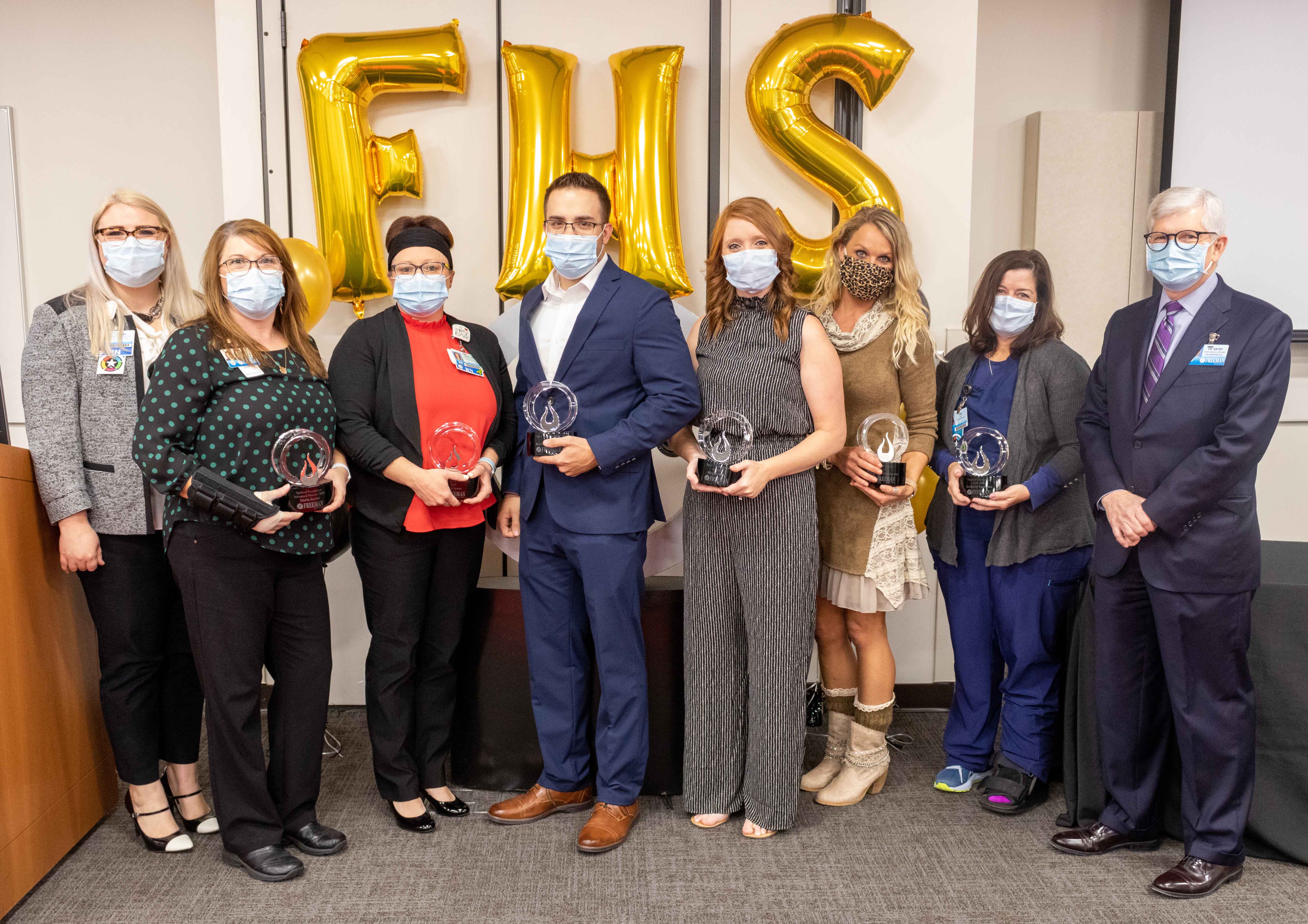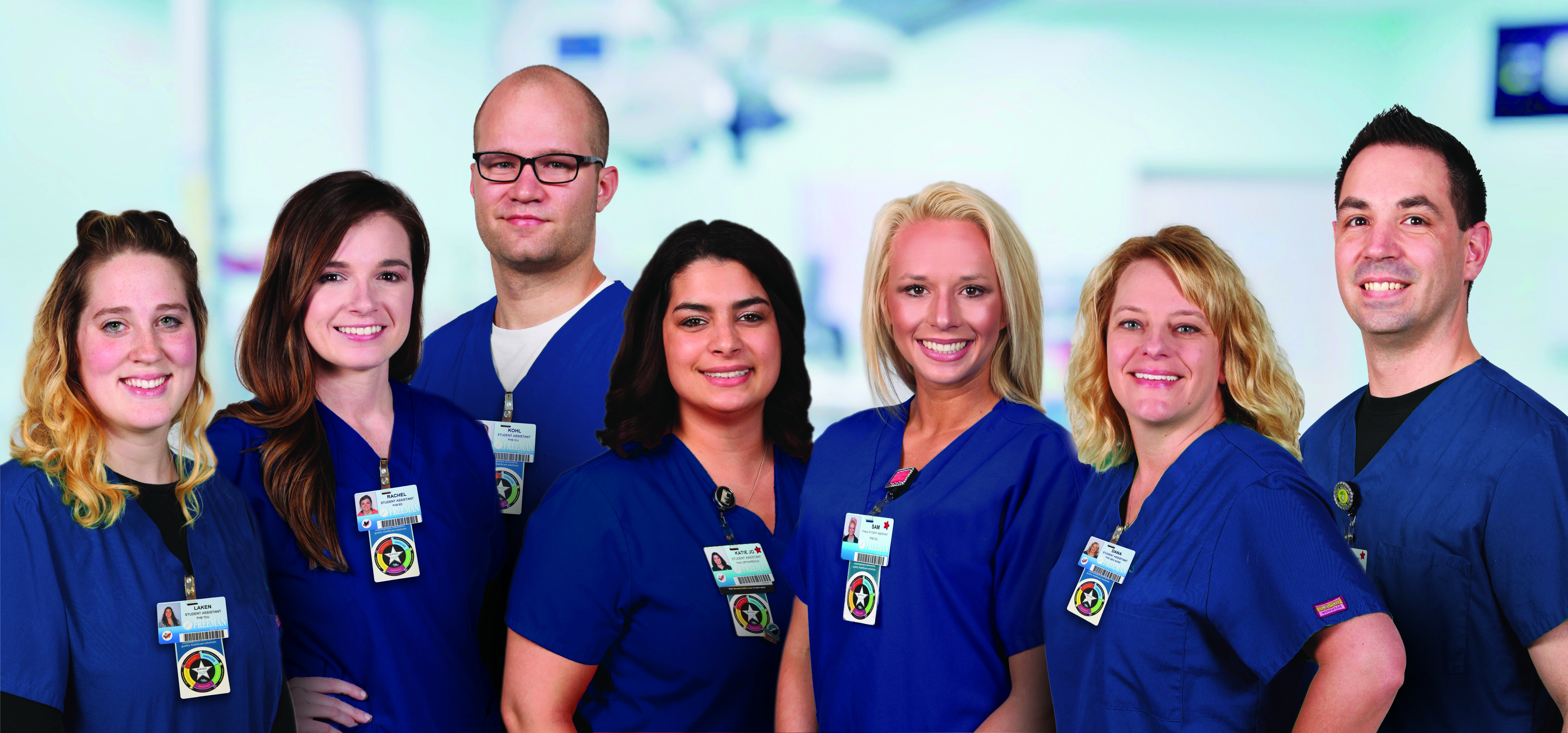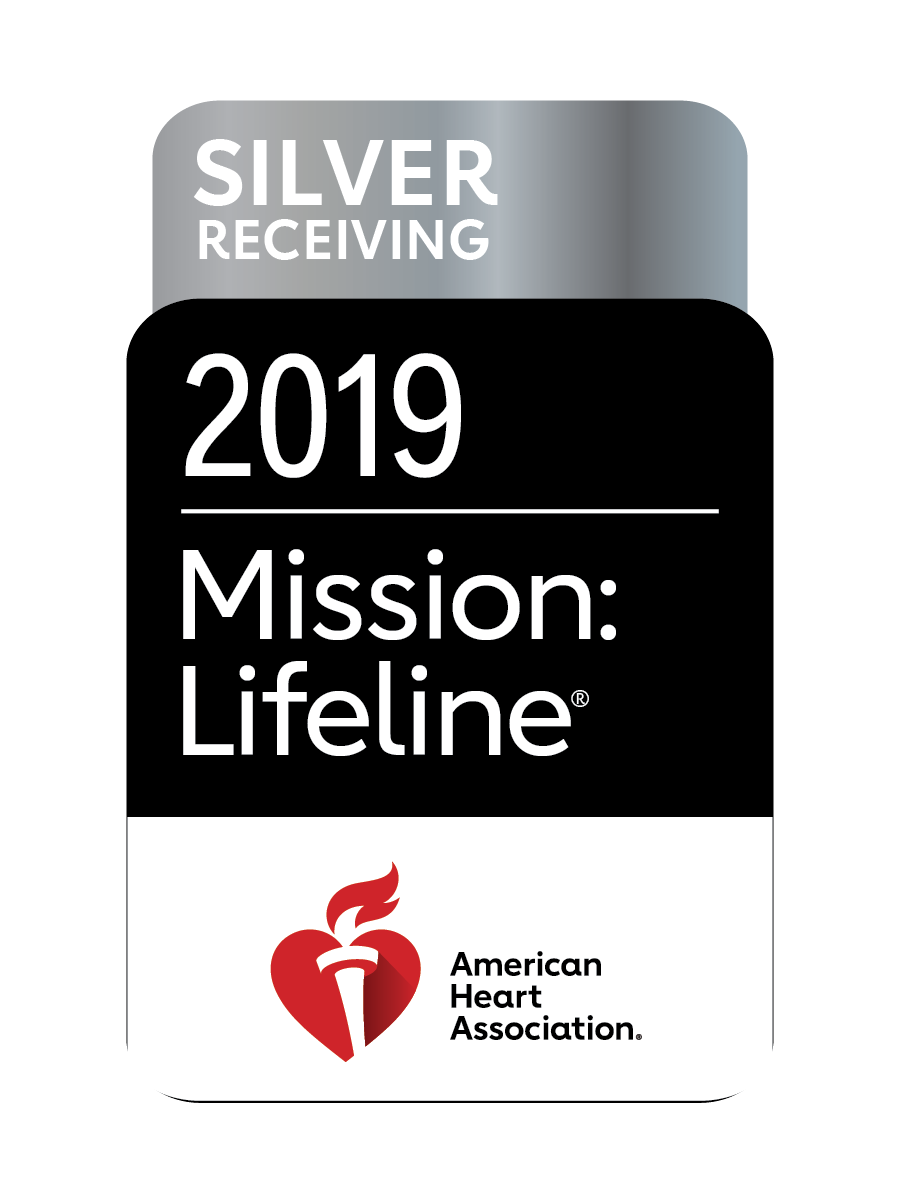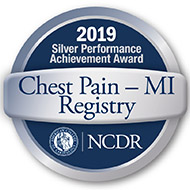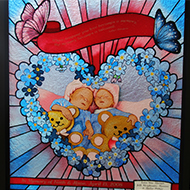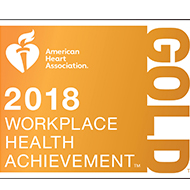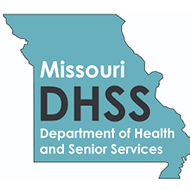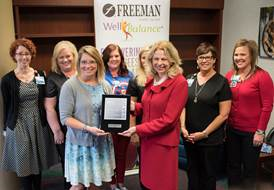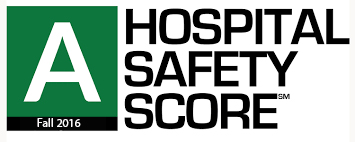Heart & Vascular Care (Cardiology)
417.347.5000
Nationally Recognized Heart Care In Your Town
Freeman Heart & Vascular Institute provides nationally recognized care for Joplin and surrounding areas. Freeman offers you rapid, expert cardiology, cardiovascular and thoracic care all in one convenient location. Services include cardiology clinics, preventive care, emergency interventions, diagnostics, open-heart surgeries, structural heart clinic and cardiac rehabilitation. The facility, a three-story wing adjacent to Freeman Hospital West, has three state-of-the-art operating suites and four cardiovascular catheterization labs. Research is an integral part of our heart and vascular program. We participate in many national studies of cardiovascular treatment. From time to time, patients may be offered the opportunity to participate in clinical trials.
Cardiology: 347.5000, Cardiovascular and Thoracic Surgery: 347.5001
Freeman Heart & Vascular Institute
Joplin, MO
Visit usLevel I STEMI Center
Minutes matter in a cardiac emergency. Freeman is designated as a Level I STEMI Center by the Missouri Department of Health and Senior Services.
The designation – the highest of four designations possible – means Freeman has a consistently proven plan and record of dealing with every aspect of ST-segment elevation myocardial infarction (STEMI), a potentially deadly heart attack. The health system is only one of 20 in Missouri and the first in Southwest Missouri to be classified under the top-level designation.
The Level I STEMI Center designation is part of the state’s Time Critical Diagnosis System, which identifies hospitals specially equipped to treat STEMI, stroke and trauma patients and improves both the speed and quality of care. The system coordinates the 911 response system, ambulance services and hospitals in a comprehensive, integrated approach.
With the Level I STEMI Center designation, Freeman is setting the standard for excellence in heart care throughout the four-state area.
Cardiothoracic Surgery
Cardiothoracic surgery provides treatment for patients with a wide range of conditions affecting the heart, as well as the respiratory and circulatory systems. We combine innovative technology with expertise and skill to provide the latest in vascular and endovascular surgical options.
Many of the procedures are performed using minimally invasive approaches through small incisions and with video assistance devices. Minimally-invasive beating heart surgery results in less pain and trauma, reduced recovery time, and reduced risk of infection. Patients experience better outcomes, spend less time away from home and return to work sooner.
As a regional center of excellence in heart care, Freeman reinvests in state-of-the-art equipment and the latest technological advancements. Our cardiothoracic surgeons focus on diagnosing and treating your condition quickly to improve your quality of life and get you back to living life as soon as possible.
Cardiothoracic surgical options:
- Off-pump coronary artery bypass
- Ross procedure (valve transplantation)
- Stent placement
- Vascular diagnostics
- Minimally invasive microwave ablation (atrial fibrillation)
- Bypass surgery
- Endovascular surgery
- Peripheral vascular surgery
- Keyhole/minimally invasive valve surgery
- Mitral valve repair
- Cardiac valve replacement and repair
- Cryoablation maze procedure
- Thoracic surgical procedures (lung surgery)
- Percutaneous peripheral vascular intervention
- Video-assisted thoracoscopy
- Aortic dissection
- Vascular access grafts
Freeman is on the Leading-Edge of Heart and Vascular Treatment
Freeman is the First in the Area to Offer These Procedures
TAVR is a minimally-invasive procedure in which a folded valve is slipped into a catheter, inserted through the groin and threaded up to the heart through the arteries. When the valve reaches its destination near the heart, a balloon inflates to open the valve and secure its position in the artery. Performed in a state-of-the-art hybrid operating room.
TAVR is done while the heart remains pumping, eliminating the need for a heart-lung machine. The procedure takes an average of 45 minutes to two hours and is done under general anesthesia. Freeman’s median length of in-patient stay post-procedure is 2.06 days.
TAVR patients begin with a referral to Freeman’s Structural Heart Program, which features a collaborative team of interventional cardiologists, cardiothoracic surgeons and echocardiologists. This team focuses on the diagnosis and treatment of conditions affecting the valves and other vital structures of the heart, providing personalized, coordinated care for the patient.
Patients go through a comprehensive screening process with the structural heart team prior to the procedure, and then that same team of physicians place the patient’s new heart valve.
The Structural Heart Program features:
- Collaborative team of interventional cardiologists, cardiothoracic surgeons and echocardiologists.
- Diagnosis and treatment of conditions affecting the valves and other vital structures of the heart.
- Personalized, coordinated care and comprehensive range of medical and surgical treatment options for patients throughout the region.
To schedule an appointment with a Freeman cardiologist, call 417.347.5000.
Dr. John Swartz, Freeman Heart & Vascular Institute cardiologist, is the first and only physician in southwest Missouri to use the Medtronic Micra™ Transcatheter Pacing System (TPS). It is the first and only leadless pacemaker in the United States as a treatment option for patients with bradycardia (slow or irregular heart rhythm). The Micra TPS is about the size of a multivitamin, making it 93 percent smaller than traditional devices and the world’s smallest pacemaker.
Freeman is the first hospital in our area to provide the Watchman® implant, a device for patients who are at a high risk for stroke and have atrial fibrillation not caused by a heart valve problem and need an alternative to blood thinners.
During the 30- to 90-minute procedure, the physician makes a small cut in the patient’s upper leg and inserts a narrow tube through the femoral artery. The physician then guides the Watchman implant, which is the size of a quarter, into the left atrial appendage of the heart. Over time it will heal in and a skin will form over the device. It excludes the left atrial appendage, so no blood clot can form in it.
The procedure is done under general anesthesia, and the patient is kept overnight for observation. After the procedure, the patient will eventually be placed on an aspirin regimen.
Types of Heart Conditions
Angina is a symptom of coronary heart disease. Angina feels like a squeezing, pressure, heaviness, tightness or pain in the chest. This discomfort happens when the blood supply to your heart becomes restricted because of your arteries becoming narrowed.
Atrial fibrillation, often called AFib or AF, is the most common type of treated heart arrhythmia. An arrhythmia is when the heart beats too slowly, too fast or in an irregular way. When a person has AFib, the normal beating in the upper chambers of the heart is irregular, and blood doesn’t flow from the atria to the lower chambers of the heart.
Coronary artery disease occurs when arteries surrounding the heart become less elastic or clogged as of result of fatty deposits (called plaque or blockage) or blood clots forming along the inside of the artery walls. This condition is also known as hardening of the arteries or atherosclerosis. Plaque causes narrowing of the arteries and forces the heart to work harder to get sufficient blood supply. This puts a strain on the heart, eventually weakening it and resulting in heart failure.
When a blood clot or plaque completely blocks a coronary artery, the portion of the muscle beyond the blockage does not receive the blood it needs. If any part of the heart is deprived of blood for more than a few minutes, permanent damage can result. This is a heart attack. During a mild heart attack, only a small portion of the heart muscle is damaged. The undamaged part of the heart works harder to compensate. If the heart muscle suffers widespread damage, there may not be enough healthy muscle to keep the heart pumping as it should. Heart failure may result.
Heart failure occurs when your heart muscle doesn’t pump blood and oxygen effectively. With heart failure, the weakened heart can’t supply the cells with enough blood. Early diagnosis and treatment can improve quality and length of life for people who have heart failure. Freeman’s Heartwise program provides education, counseling and close monitoring of your cardiac condition. Learn more about Heartwise below.
Blood pressure is the force of blood pushing against the artery walls when the heart beats. Normally, artery walls are elastic, so they stretch and contract, adjusting to the beating and resting of the heart. As arteries become scarred, hardened or narrowed, they lose elasticity, which puts more pressure on artery walls. Blood moves inefficiently, and the heart must pump harder to push blood through the arteries. When blood pressure remains high for a long time, it can cause thickening or enlargement of the heart’s ventricles. Eventually, the ventricles can no longer pump efficiently, resulting in heart failure.
The valves between the chambers of your heart keep blood moving forward. When a valve narrows, it restricts the blood flow through the heart, causing an abnormal amount of blood to collect on one side of the valve. This causes the chamber to thicken and pump harder with each beat. Over time, the chamber can weaken. If a valve does not close tightly, blood leaks backward. This strains the heart and causes it to enlarge and hold more blood than it should. In some cases, surgery is required to repair or replace the abnormal valve. Valve disease can lead to heart failure.
Sometimes when the heart is damaged by diseases such as infection, alcoholism or toxic effects of certain drugs, the chambers enlarge and the heart muscle stretches and weakens, which prevents the heart from pumping effectively.
Heartwise - Heart Failure Clinic
You may have felt alarmed to learn you have a chronic cardiac condition. Although receiving this diagnosis may have frightened you, it is treatable. While your heart no longer works as well as it should, many people live with this condition without ever suffering a heart attack. With the right team in place, the right medications and devices prescribed as needed, and the right lifestyle changes, you can enjoy a healthy, happy life. That’s where Heartwise, an initiative focused on empowering patients to better manage their chronic cardiac conditions, can help.
A chronic cardiac condition usually occurs as the result of a diseased or damaged heart. While many conditions can weaken the heart, common conditions are:
- Coronary artery disease
- Heart attack
- High blood pressure
- Valve disease
- Cardiomyopathy
Symptoms of a chronic cardiac condition can range from mild to severe and vary from person to person. Depending on the cause, symptoms can manifest suddenly or develop gradually. A very mild condition may show no visible signs at all. It is important to recognize the signs as soon as they appear, and treat the condition early with the help of your cardiac healthcare team. Treatment varies from patient to patient. Your cardiac healthcare team will determine the treatment plan that will work best for you.
For more information, call Freeman Heart & Vascular Institute at 417.347.5000.
PATIENT STORY
Meet John Tescher - TAVR patient
Before transcatheter aortic valve replacement, or TAVR for short, I was really weak. Just walking across the room, I’d have to sit down and take a break. Dr. John Cox said my aortic valve was calcified from age. He said when you’re doing something active, like walking, it should transfer fluid from one part of the heart to the other, but mine wasn’t doing that. That’s why I was tired a lot.
I have a couple other problems – diabetes, Addison’s disease and heart disease – and I’ve had two heart attacks and other heart procedures in the past, so I wasn’t a candidate for open-heart surgery. Dr. Cox recommended TAVR.
I was one of the first people to have TAVR done at Freeman. I was excited about it. I was a little nervous about stepping into the unknown of a new procedure, but I knew that if it worked, it would be beneficial to my daily life.
They did the procedure on a Thursday, and I was discharged the next day. I noticed the improvement right away. I felt great again. The only pain was in the groin where they’d inserted the catheter.
Now, my life is back to normal again. I’ve regained my energy and my strength. I can do whatever I want to do – I can work on my yard or go shopping with my wife. I feel good.
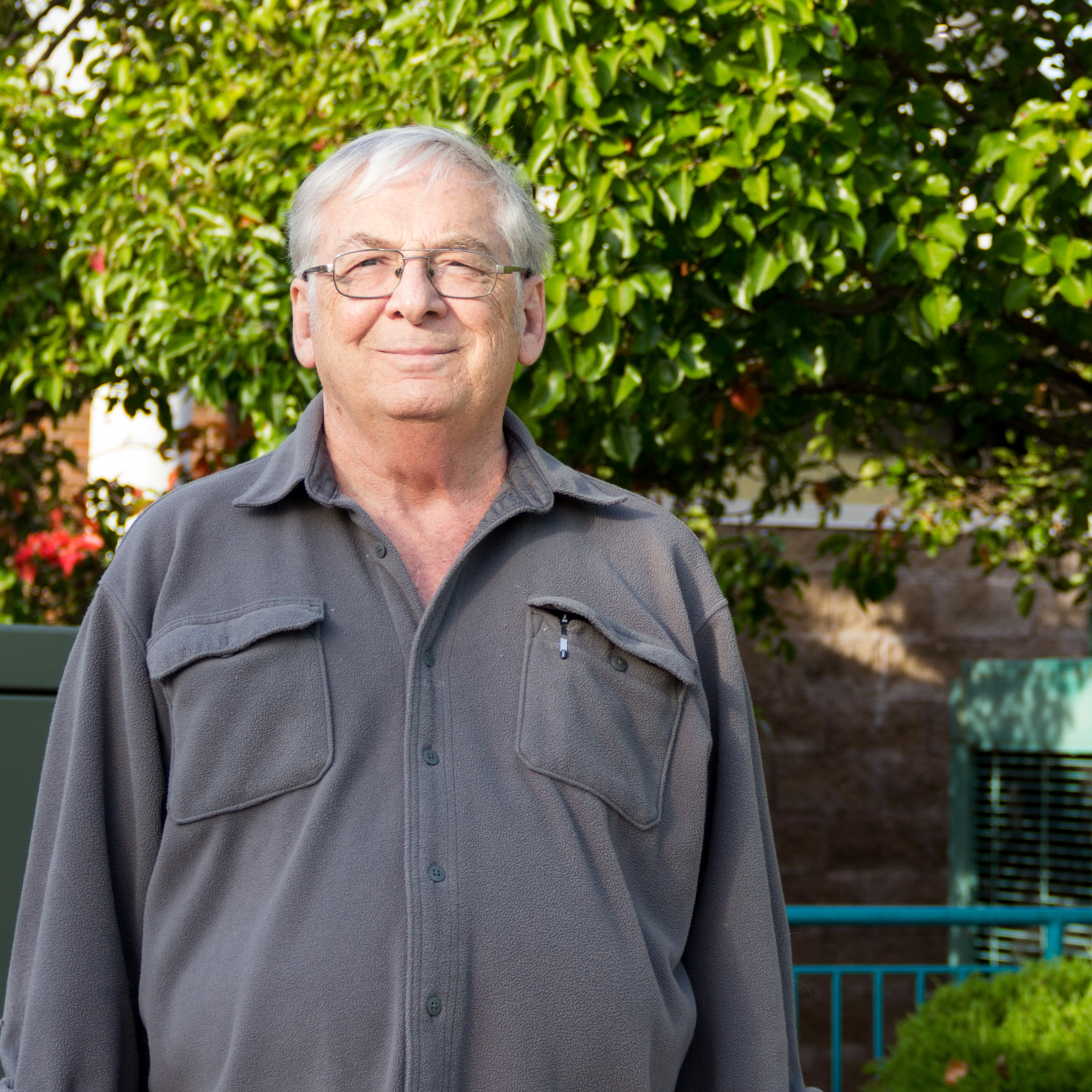
Helpful Resources
Celebrate National Wear Red Day® with Go Red For Women and Freeman Health System to help fight women's #1 killer – heart disease.
Heart disease claims more lives than all forms of cancer combined. For more than 10 years, the American Heart Association has sponsored National Wear Red Day® to raise awareness in the fight against heart disease in women.
2014 was the 11th year anniversary for National Wear Red Day® and during that time, there have been some major accomplishments, including:
- 21 percent fewer women dying from heart disease
- 23 percent more women aware that it’s their #1 health threat
- The publishing of gender-specific results, established differences in symptoms and responses to medications, and women-specific guidelines for prevention and treatment
- Legislation to help end gender disparities
What causes heart disease?
Heart disease affects the blood vessels and cardiovascular system. Numerous problems can result from this, many of which are related to a process called atherosclerosis, a condition that develops when plaque builds up in the walls of the arteries. This buildup narrows the arteries, making it harder for blood to flow through. If a blood clot forms, it can stop the blood flow. This can cause a heart attack or stroke.
But it doesn’t end there. Heart disease can take many other forms as well:
- Heart failure or congestive heart failure, which means that the heart is still working, but it isn’t pumping blood as well as it should, or getting enough oxygen.
- Arrhythmia or an abnormal rhythm of the heart, which means the heart is either beating too fast, too slow or irregularly. This can affect how well the heart is functioning and whether or not the heart is able to pump enough blood to meet the body’s needs.
- Heart valve problems can lead to the heart not opening enough to allow proper blood flow. Sometimes the heart valves don’t close and blood leaks through, or the valve leaflets bulge or prolapse into the upper chamber, causing blood to flow backward through them.
How can I prevent it?
Many factors can put you at risk for these problems – some you can control and others you can’t. But the key takeaway is that with the right information, education, and care, heart disease in women can be treated, prevented, and even ended.
Studies show that healthy choices have resulted in 330 fewer women dying from heart disease per day. Here are a few lifestyle changes you should make:
- Don’t smoke
- Manage your blood sugar
- Don’t smoke
- Get your blood pressure under control
- Lower your cholesterol
- Know your family history
- Stay active
- Lose weight
- Eat healthfully
Eating foods low in cholesterol and saturated fats can significantly reduce your risk for heart disease. Though your favorite foods often include ingredients to avoid, you can eat right and still enjoy your meals if you follow a few simple guidelines:
- Limit your cholesterol intake to 300 milligrams per day and total fat to less than 30% of a day’s calories, including no more than 10% of calories from saturated fats. Check food labels for fat content.
- Cholesterol is found in animal products such as meat, eggs and cheese. Saturated fats, those that remain solid at room temperature, are most commonly found in fatty cuts of meat, whole milk products, butter, and palm and coconut oils.
- Eat plenty fruits, vegetables, whole grains and legumes such as dried peas and beans. These foods are rich in vitamins and can also help keep your cholesterol levels down.
- Know that it’s okay to use butter and dressing as long as you use them in smaller portions. Also, give low-fat or nonfat products a try.
Additionally, it’s important to know the symptoms of a heart attack so you can act right away. The signs of a heart attack aren't the same for everyone. For some, symptoms are sudden and intense. For others, the symptoms are mild and begin slowly. Know the warning signs and act quickly – by calling 911 or going to the nearest emergency room – if you think you're having a heart attack.
A heart attack does not always have obvious symptoms, such as pain in your chest, shortness of breath and cold sweats. In fact, a heart attack can actually happen without a person knowing it. It is called a silent heart attack, or medically referred to as silent ischemia (lack of oxygen) to the heart muscle.
It’s important to know your risk factors, be aware of your blood pressure and cholesterol, exercise regularly and avoid smoking to decrease your risk of a heart attack. Above all, listen to your body, and if something isn’t right, talk to a doctor.
To schedule an appointment (with a referral), call 417.347.5000 or request an appointment online.
The signs of a heart attack aren't the same for everyone. For some, symptoms are sudden and intense. For others, the symptoms are mild and begin slowly. Know the warning signs and act quickly—by calling 911 or going to the nearest emergency room—if you think you're having a heart attack.
Symptoms of a heart attack:
- Discomfort/pain in center of chest that lasts more than a few minutes or goes away and comes back
- Discomfort in the arm(s), back, neck, jaw, or stomach
- Shortness of breath
- Breaking out in a cold sweat, nausea, or light-headedness
Some heart attack symptoms are more common in women than in men:
- Stomach, abdominal pain, or unusual chest pain
- Nausea or dizziness
- Shortness of breath and difficulty breathing
- Unexplained anxiety, weakness, or fatigue
- Palpitations, cold sweat, or paleness
The cardiologists at Freeman Heart & Vascular Institute use a variety of noninvasive tests to diagnose heart disease and conditions such as angina (chest pain). These tests include state-of-the-art echocardiography, contrast echo, and regular treadmill, stress echo, dobutamine stress echo, and nuclear medicine stress tests. Additionally, Freeman offers computed tomography (CT) and positron emission tomography/computed tomography (PET) imaging.
Registered vascular technology specialists staff our noninvasive, diagnostic lab for vascular testing using state-of-the-art ultrasound equipment. Tests include cerebral vascular testing, peripheral arterial testing, peripheral venous testing and abdominal Doppler exams.
Cardiopulmonary rehabilitation improves a patient’s ability to perform the normal activities of daily living. By teaching techniques for dealing with chest pain, shortness of breath, eating habits, cholesterol levels and weight loss, the Freeman Cardiopulmonary Rehabilitation program provides a comfortable and familiar environment for recovery. Services are available in Joplin and Neosho.
What are the Benefits of Cardiopulmonary Rehab?
Cardiopulmonary rehabilitation can help you:
Improve your ability to perform the normal activities of daily living.
• Increase your tolerance for exercise and reduce your fear of an exercise program.
• Learn techniques for dealing with chest pain and shortness of breath.
• Learn eating habits to lower your cholesterol levels and lose weight.
• Find relief from the discomfort caused by heart and pulmonary diseases.
What is Cardiac Rehab?
If you have recently undergone a cardiac procedure or been diagnosed with a cardiac disease, you may have a long road to recovery ahead of you. Freeman Cardiac Rehabilitation is ready to help you down that road. With your hard work and our guidance, you can soon begin feeling like yourself again. Cardiac rehabilitation will help you make lifestyle changes that can slow, stop or even reverse the damaging process of heart disease. Freeman’s multi-disciplinary team can help you make these important changes.
Aerobic exercise enhances the entire recovery process. It strengthens your heart muscle as well as the muscles of your arms and legs. It increases the amount of exercise you can perform and more importantly, demonstrates that a full recovery is possible and enjoyable. You will also receive dietary counseling to reduce your cholesterol levels. If you smoke, we can also help you quit.
PHASES OF CARDIAC REHABILITATION
Phase I – Inpatient Cardiac Rehabilitation
Rehabilitation begins in the hospital with education and appropriate exercise therapy to restore strength.
Phase II – Outpatient Cardiac Rehabilitation
Your physician will recommend outpatient cardiac rehab. This phase consists of continuous EKG monitoring, routine vital signs checks, aerobic exercise, stretching exercises and health education. During this phase, emphasis is placed on making permanent changes in your dietary and exercise habits.
Phase III – Maintenance
You will learn how to maintain your exercise program and establish lifelong habits.
What is Pulmonary Rehab?
Pulmonary rehabilitation can help reduce the frequency and length of your hospital stays if you suffer from any of the following pulmonary diagnoses:
- Asthma
- Chronic bronchitis
- Lung resection
- COPD
- Shortness of breath
- Cystic fibrosis
- Emphysema
- Bronchiectasis
- Lung transplant
- Occupational or environmental lung disease
During pulmonary rehab, our staff will work with you to improve your respiratory function and help you find relief from the symptoms of pulmonary disease.
PHASES OF PULMONARY REHAB
Phase I – Inpatient Pulmonary Rehab
Rehabilitation begins in the hospital with education and appropriate exercise therapy for pulmonary disease.
Phase II - Outpatient Pulmonary Rehabilitation
Your physician will recommend outpatient pulmonary rehab. This phase consists of exercise therapy and respiratory therapy.
Phase III - Maintenance
You will learn how to maintain your exercise program and establish lifelong habits.
Freeman Cardiopulmonary Rehabilitation
Phone: 417.347.3533, voicemail available
Monday, Wednesday, Friday: 7:30 am – 3:30 pm
Tuesday and Thursday: 8:00 am – 2:30 pm
Did you know the first “symptom” of cardiovascular disease can be a heart attack? Early detection of heart problems gives individuals a chance to seek treatment and make lifestyle changes, decreasing the likelihood of a cardiac event.
Early detection tests can be as simple as monitoring your blood pressure and your cholesterol. Both high blood pressure and high cholesterol can be controlled with lifestyle changes and/or medication.
Getting your cardiac calcium score is an even more accurate way to determine cardiovascular risk. This test uses a non-invasive heart to can measure the calcium deposits in the walls of your coronary arteries – the arteries that supply blood to your heart – all without needles, cutting or medication.
If the test shows that you are at an elevated risk for a heart attack, you can work with your doctor to begin to lower your risk by preventing future buildup of calcium and plaque in your arteries.
Although anyone can get this screening, it is recommended for men over 40 and women over 45 who have one of the following risk factors:
- Diabetic
- Current smoker
- Obese
- Family history of heart disease
- Cholesterol level greater than 160/LDL
- Blood pressure greater than 140/90
$99
Not covered by insurance
Talk to your doctor for more information.
Preventing Heart Disease
Many factors can put you at risk for these problems – some you can control and others you can’t. But the key takeaway is that with the right information, education, and care, heart disease in women can be treated, prevented, and even ended.
Studies show that healthy choices have resulted in 330 fewer women dying from heart disease per day. Here are a few lifestyle changes you should make:
- Don’t smoke
- Manage your blood sugar
- Don’t smoke
- Get your blood pressure under control
- Lower your cholesterol
- Know your family history
- Stay active
- Lose weight
- Eat healthfully
Eating foods low in cholesterol and saturated fats can significantly reduce your risk for heart disease. Though your favorite foods often include ingredients to avoid, you can eat right and still enjoy your meals if you follow a few simple guidelines:
- Limit your cholesterol intake to 300 milligrams per day and total fat to less than 30% of a day’s calories, including no more than 10% of calories from saturated fats. Check food labels for fat content.
- Cholesterol is found in animal products such as meat, eggs and cheese. Saturated fats, those that remain solid at room temperature, are most commonly found in fatty cuts of meat, whole milk products, butter, and palm and coconut oils.
- Eat plenty fruits, vegetables, whole grains and legumes such as dried peas and beans. These foods are rich in vitamins and can also help keep your cholesterol levels down.
- Know that it’s okay to use butter and dressing as long as you use them in smaller portions. Also, give low-fat or nonfat products a try.
It’s important to know your risk factors, be aware of your blood pressure and cholesterol, exercise regularly and avoid smoking to decrease your risk of a heart attack. Above all, listen to your body, and if something isn’t right, talk to a doctor.
For more information, call Freeman Heart & Vascular Institute at 417.347.5000.
Many factors can put your heart at risk. While you cannot control them all, actions like exercising regularly and abstaining from tobacco use can lower your risk.
Uncontrollable factors
- Age – Individuals over 65 are at increased risk.
- Sex – Men are at greater risk than women.
- Ethnicity – African-Americans, Mexican-Americans, American Indians, native Hawaiians and some Asian-Americans have a higher risk of heart disease than Caucasians.
- Family history – Individuals with a family history of cardiovascular disease have a higher risk than those who do not.
Controllable factors
- Tobacco use
- High blood pressure
- High cholesterol
- Obesity
- Physical inactivity
- Diabetes
Cardiac/Medical 1
In 2007, the Tower opened at Freeman West. In consideration of future expansion, our senior leaders and Board of Directors left two extra floors unfinished: the 5th and 6th floors. After the May 22, 2011 tornado, Freeman experienced a 20 percent increase in the number of patients staying in the hospital. To meet this demand, Freeman finished these floors, adding 58 private patient rooms, 29 of those in the Cardiac/Medical Unit
Our goal for this expansion was to reduce wait times and make each patient's hospital experience as pleasant as possible. Each of the spacious rooms on the 5th and 6th floors are private, with patient-centered amenities, such as a family area in each room and a place for visitors to sleep.
The 5th floor opened in March 2012. On the 5th floor, the Cardiac/Medical Unit serves our stroke, low-risk cardiac and medical patients. Each patient bed is equipped with continuous oxygen saturation and advanced wireless cardiac monitoring technology. Nurses on this floor have advanced cardiac training as well.
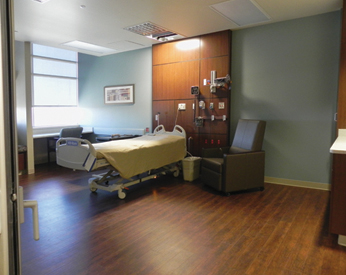
Cardiac/Medical 2
The Cardiac/Medical 2 Unit (CMU-2) opened in the fall of 2013. On the 6th floor, CMU-2 serves as our renal caring unit for patients suffering from kidney disease. Each patient bed is equipped with advanced wireless cardiac monitoring technology, and nurses on this floor have advanced cardiac and dialysis training. The unit has dialysis access for ease in the management of patient care and for patient convenience.
Patients in both of these new units communicate with nursing staff through a new call light system, chosen by nurses involved in the Shared Governance program. This new system improves efficiency, collaboration and quality of patient care.
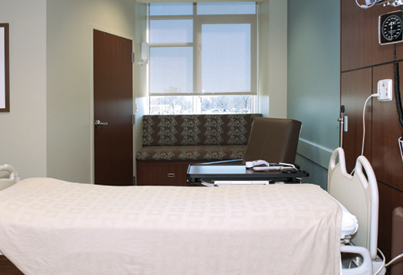
Take-a-Break Snack Mix
Ingredients
- Cooking spray
- 1/4 cup sliced almonds
- 1 tablespoon light brown sugar
- 2 teaspoons water
- 1/4 teaspoon ground cinnamon
- 1/8 teaspoon ground nutmeg
- 2 cups whole-grain oat cereal with yogurt-flavored coating
- 2 cups whole-grain wheat and bran flakes with raisins
- 1/2 cup dried unsweetened cranberries
- 1/2 cup dried unsweetened blueberries
Cooking instructions
Put a piece of aluminum foil about 12 inches square on a platter or baking sheet. Lightly spray with cooking spray. Set aside. In a small nonstick skillet, dry-roast the almonds over medium heat for 2 to 3 minutes, or until lightly golden brown, stirring occasionally.Stir in the brown sugar, water, cinnamon, and nutmeg. Cook for 1 to 2 minutes, or until the liquid has evaporated and the almonds are coated with the mixture, stirring constantly. Transfer to the foil. Let cool completely, 15 to 20 minutes. Meanwhile, in a medium bowl, stir together the remaining ingredients. Add the cooled almonds to the cereal mixture, stirring to combine. Store in an airtight container for up to 7 days.
Cook's tip
Whether your schedule is go-go-go or hurry-up-and-wait, you’ll be glad you packed these tasty tidbits for healthy snacking. For variety, substitute different nutrient-dense dried fruits, such as cherries, apricots, and plums, for the cranberries and blueberries. Cut them into 1/4- to 1/2-inch pieces before adding them to the cereal mixture.
Nutritional Analysis Per Serving
139 calories, 2.0 g total fat, 0.5 g saturated fat, 0 g trans fat, 5. g polyunsaturated fat, 1 g monounsaturated fat, 0 mg cholesterol, 124 mg sodium, 28 g carbohydrates, 4 g fiber, 15 g sugar, 2 g protein
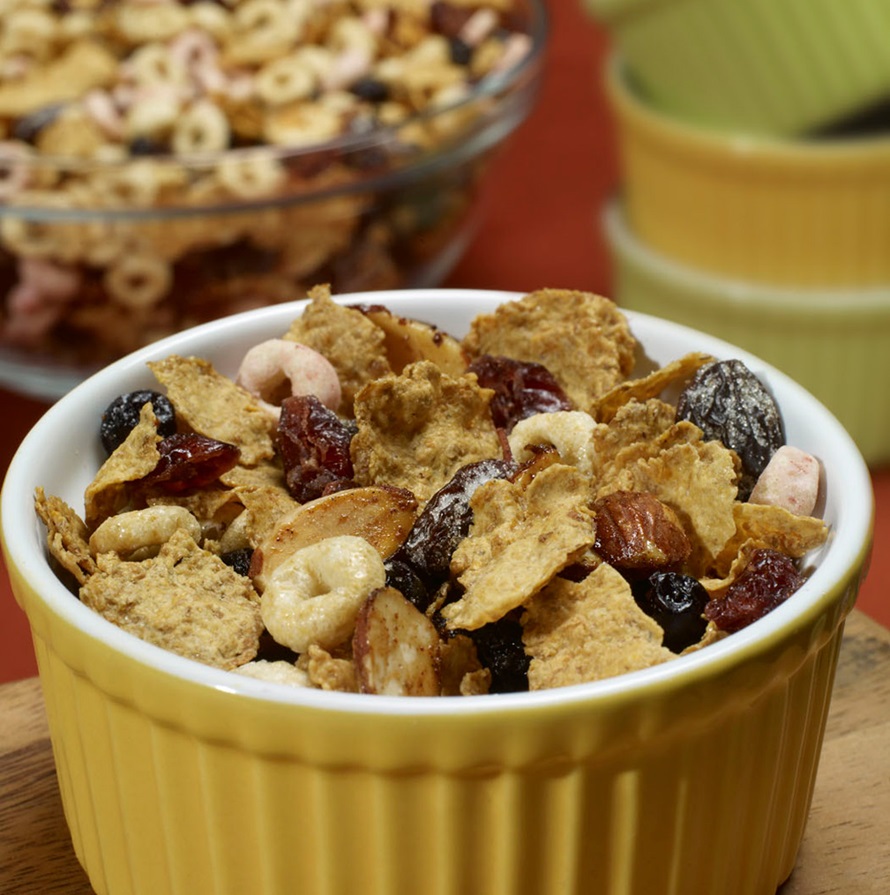
Shredded Root Vegetable Pancakes
Ingredients
- 1 large egg, lightly beaten
- 1/4 cup whole-wheat flour
- 3 tablespoons chopped scallions
- 1 tablespoon chopped fresh dill or 1 teaspoon dried
- 1 tablespoon prepared horseradish
- 1/4 teaspoon salt
- 1/4 teaspoon freshly ground pepper
- 4 cups assorted root vegetables, peeled (about 1 1/2 pounds; see Cook Tip) and shredded
- 2 slices cooked bacon, crumbled (optional)
- 6 teaspoons canola oil, divided
- Reduced-fat sour cream for garnish
Cooking Instructions
Preheat oven to 400°F. Coat a baking sheet with cooking spray. Whisk egg, flour, scallions, dill, horseradish, salt and pepper in a large bowl. Stir in vegetables and bacon (if using). Heat 2 teaspoons oil in a large nonstick skillet over medium heat. Cook 4 pancakes per batch: place about 1/4 cup vegetable mixture in a little of the oil and press with the back of a spatula to flatten into a 2- to 3-inch pancake. Cook until crispy and golden, 1 1/2 to 3 minutes per side. Transfer the pancakes to the prepared baking sheet. Continue with 2 more batches, using the remaining 4 teaspoons oil and vegetable mixture. Transfer the baking sheet to the oven and bake for 15 minutes. Serve garnished with sour cream, if desired.
Cook's Tip
Beets, carrots and parsnips are easily peeled with a vegetable peeler, but for tougher-skinned roots like celeriac, rutabaga and turnips, removing the peel with a knife can be easier. Cut off one end of the root to create a flat surface to keep it steady on the cutting board. Follow the contour of the vegetable with your knife. If you use a vegetable peeler on the tougher roots, peel around each vegetable at least three times to ensure all the fibrous skin has been removed. Serves 6.
Serving size
2 pancakes
Nutritional Analysis Per Serving
106 calories, 6 g total fat, 1 g saturated fat, 3 g monounsaturated fat, 35 mg cholesterol, 180 mg sodium, 12 g carbohydrates, 3 g fiber, 3 g protein, and 294 mg potassium
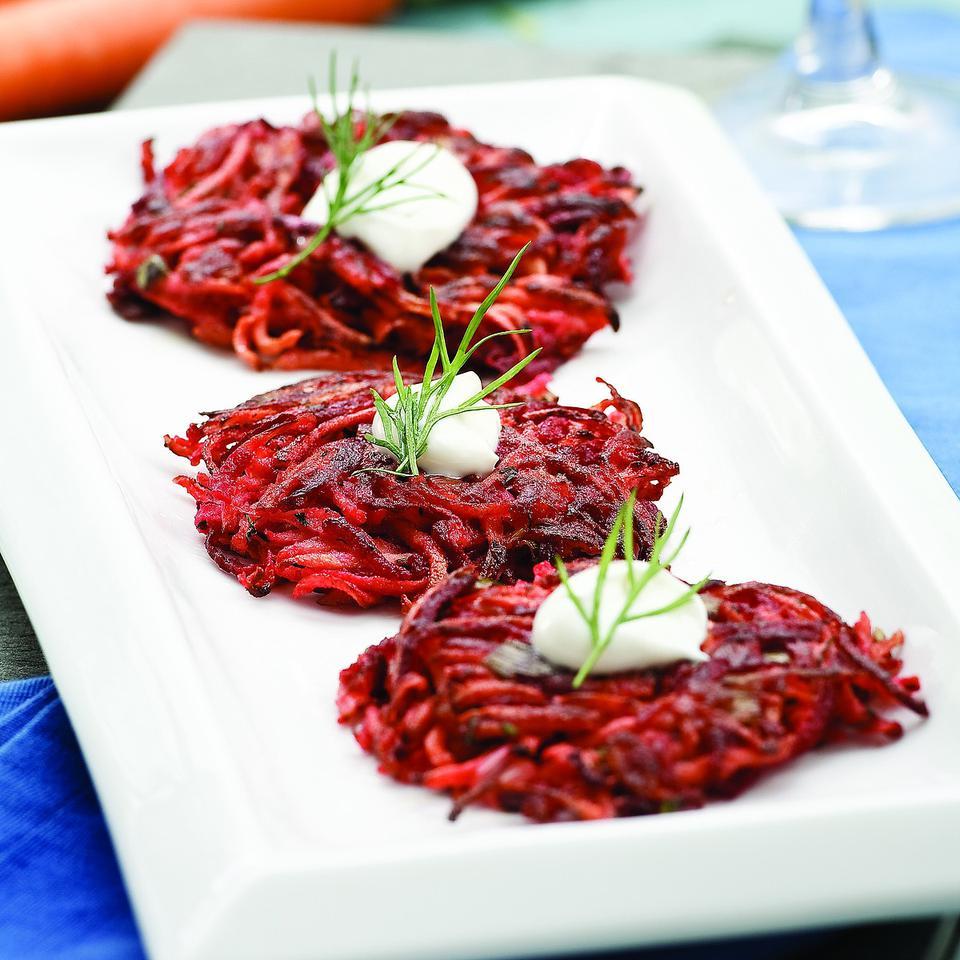
Oven-Fried Chicken
Ingredients
- 1/2 cup nonfat buttermilk (see Cook Tips)
- 1 tablespoon Dijon mustard
- 2 cloves garlic, minced
- 1 teaspoon hot sauce
- 2 1/2-3 pounds whole chicken legs, skin removed, trimmed and cut into thighs and drumsticks
- 1/2 cup whole-wheat flour
- 2 tablespoons sesame seeds
- 1 1/2 teaspoons paprika
- 1 teaspoon dried thyme
- 1 teaspoon baking powder
- 1/8 teaspoon salt
- Freshly ground pepper to taste
- Olive oil cooking spray
Cooking Instructions
Whisk buttermilk, mustard, garlic and hot sauce in a shallow glass dish until well blended. Add chicken and turn to coat. Cover and marinate in the refrigerator for at least 30 minutes or for up to 8 hours. Preheat oven to 425°F. Line a baking sheet with foil. Set a wire rack on the baking sheet and coat it with cooking spray. Whisk flour, sesame seeds, paprika, thyme, baking powder, salt and pepper in a small bowl. Place the flour mixture in a paper bag or large sealable plastic bag. Shaking off excess marinade, place one or two pieces of chicken at a time in the bag and shake to coat. Shake off excess flour and place the chicken on the prepared rack. (Discard any leftover flour mixture and marinade.) Spray the chicken pieces with cooking spray. Bake the chicken until golden brown and no longer pink in the center, 40 to 50 minutes. Serves 4.
Cook's tip
No buttermilk? You can use buttermilk powder prepared according to package directions. Or make “sour milk”: mix 1 tablespoon lemon juice or vinegar to 1 cup milk. To make ahead:, marinate the chicken for up to 8 hours.
Nutritional Analysis Per Serving
224 calories, 7 g total fat, 2 g saturated fat, 2 g monounsaturated fat, 130 mg cholesterol, 237 mg sodium, 5 g carbohydrates, 1 g fiber, 34 g protein, 400 mg potassium
Garlic-Chile Flank Steak
Ingredients
- 2 cloves garlic, minced
- 1/4 cup white vinegar
- 2 tablespoons canola oil
- 2 teaspoons ground ancho chile pepper (see Cook Tips)
- 1 teaspoon dried oregano
- 1 teaspoon ground cumin
- 1/4 teaspoon salt
- 1-1 1/4 pounds flank steak, trimmed of fat
Cooking instructions
Whisk garlic, vinegar, oil, ground chile, oregano, cumin and salt in a small bowl. Place steak in a shallow baking dish and pour marinade over it, turning to coat both sides. Cover and refrigerate for at least 1 hour, turning once, or overnight. Preheat grill to high heat. Oil the grill rack (see Cook Tips). Grill the steak until desired doneness, 5 to 6 minutes per side for medium. Transfer to a plate, cover with foil and let rest for 5 minutes. Slice the steak very thinly across the grain. Serve warm or chilled. Serves 8.
Cook's tip
To oil a grill: oil a folded paper towel, hold it with tongs and rub it over the rack. Do not use cooking spray on a hot grill. When grilling delicate foods like tofu and fish, it is helpful to spray the food with cooking spray.
Serving size
1.5 ounces
Nutritional Analysis Per Serving
98 calories, 5 g total fat, 2 g saturated fat, 2 g monounsaturated fat, 23 mg cholesterol, 55 mg sodium, 12 g protein, 146 mg potassium.
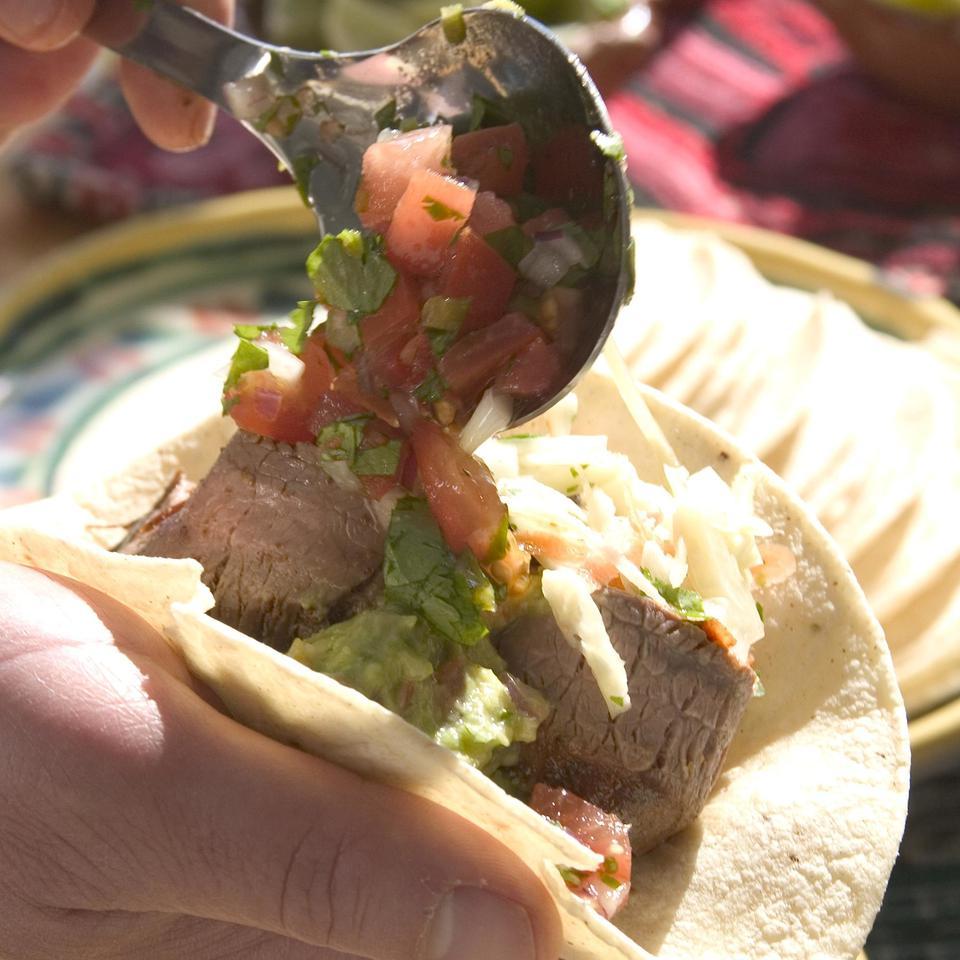
Devil's Food Cupcakes with Almond-Mocha Topping on Raspberry Sauce
Ingredients
- Cooking spray
- Cupcakes
- 1 18.25-ounce box devil’s food cake mix
- 1 2.5-ounce jar baby food pureed prunes
- 1 cup strong coffee, or 1 cup water plus 2 teaspoons instant coffee granules
- 3 large egg whites
- 2 tablespoons canola or corn oil
- Sauce
- 2 12-ounce packages frozen unsweetened raspberries, thawed
- 1/2 cup sugar
- 1 1/2 tablespoons cornstarch
- 1 teaspoon vanilla extract
Topping
- 2 teaspoons instant coffee granules
- 2 teaspoons water
- 8 ounces frozen fat-free whipped topping, thawed in refrigerator
- 2/3 cup sliced almonds, dry-roasted
Cooking instructions
Preheat the oven to 325°F, or as directed on the package. Lightly spray two 12-cup muffin pans with cooking spray. In a large mixing bowl, combine the cupcake ingredients. Follow the package directions for beating the batter and baking and cooling the cupcakes. Meanwhile, in a medium saucepan, stir together the raspberries, sugar, and cornstarch until the cornstarch is dissolved. Bring to a boil over medium-high heat. Boil for 1 to 1 1/2 minutes, or until thickened, stirring frequently. Remove from the heat. Let cool completely, about 20 minutes. Stir in the vanilla. In a medium bowl, stir together the coffee granules and water until the coffee is dissolved. Fold in the whipped topping until well blended. Cover and refrigerate until needed. For each serving, spread 1 tablespoon plus 2 teaspoons raspberry sauce on a dessert plate, top with a cupcake, spoon 1 tablespoon plus 2 teaspoons whipped topping mixture over the cupcake, and sprinkle with about 1 1/2 teaspoons almonds. Serves: 24
Cook's Tip
When shopping for cake mix, read the Nutrition Facts labels and choose a product with 0 grams of trans fat. You can refrigerate any leftovers from this recipe for up to 48 hours or freeze them for later use. Keep the cupcakes, the sauce, and the whipped topping in separate airtight containers.
Serving Size
1 cupcake
Nutritional Analysis Per Serving
173 calories, 4 g total fat, 1 g saturated fat, 0 g trans fat, 1 g polyunsaturated fat, 2 g monounsaturated fat, 0 mg cholesterol, 198 mg sodium, 31 g carbohydrates, 2 g fiber, 18 g sugar, 2 g protein

Freeman is proud to have been the event sponsor for the 2022 Four States Heart Walk! Freeman had 12 teams, 75 walkers and raised over $5,600 for this event! Learn more.
